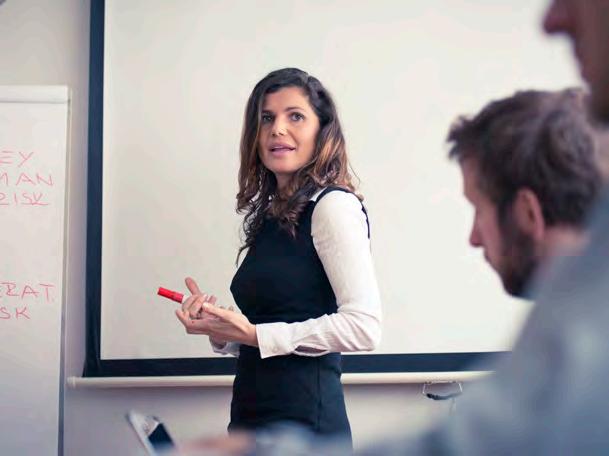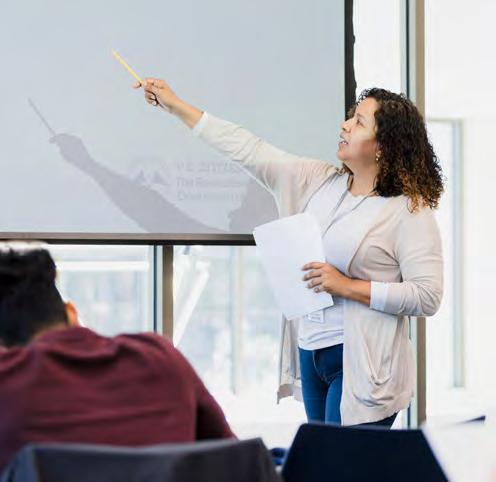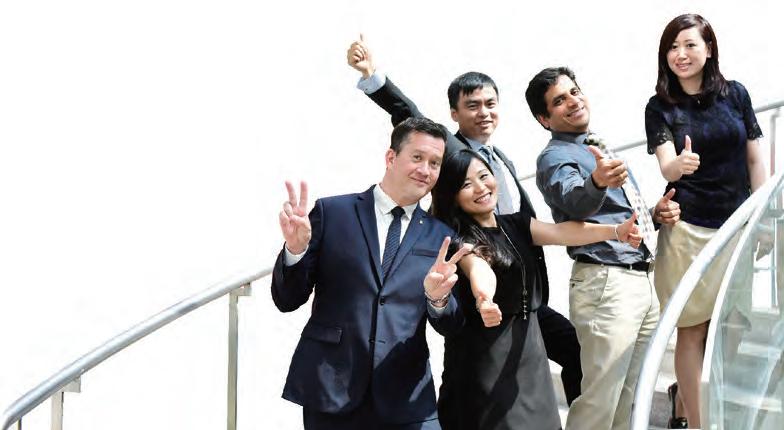



































































































































































































The EFMD Business Magazine | Iss1 Vol.17 | www.efmd.org Business School Sustainability Revisited: Sustainable No More?
Global Responsibility?
We hold the questions to which there are no simple answers and on which we must urgently act. Join a collaborative and impactoriented inquiry focused on making global responsibility real in how we learn, live and lead.

Visit grli.org

In strategic partnership with



Global Focus
The EFMD Business Magazine Iss.1 Vol.17 | 2023
Executive Editor
Matthew Wood / matthew.wood@efmdglobal.org
Advisory Board
Eric Cornuel
Howard Thomas
John Peters
Design & Art Direction
Jebens Design / www.jebensdesign.co.uk
Photographs & Illustrations
©Jebens Design Ltd / EFMD unless otherwise stated
Editorial & Advertising
Matthew Wood / matthew.wood@efmdglobal.org Telephone: +32 2 629 0810
www.globalfocusmagazine.com www.efmd.org
©EFMD
Rue Gachard 88 – Box 3, 1050 Brussels, Belgium
More ways to read Global Focus
You can read Global Focus in print, online and on the move, in English, Chinese, Russian or Spanish
Go to globalfocusmagazine.com to access the online library of past issues
Your say
We are always pleased to hear your thoughts on Global Focus, and ideas on what you would like to see in future issues.
Please address comments and ideas to Matthew Wood at EFMD: matthew.wood@efmdglobal.org
3
Business School Sustainability Revisited: Sustainable No More?
Kai Peters and Howard Thomas reflect on their 2011 Global Focus article and 2018 book, and update the thoughts and developments since then
11
Is small beautiful? An exploration of Micro-credentials
A panel of experts consider: “Is small beautiful?”, hoping to shed some light onto the subject of micro-credentials, a topic that both excites and exercises policymakers, employers, educators, and learners
17
Defining environmental challenges
CEMS academics and corporate partners explore the implications for business leaders and schools alike 23
Academics working across the boundaries - conflict of interest or mutual enrichment?
In contrast to most of their counterparts in the corporate sector, business school academics are often given the opportunity (if not encouraged by some schools) to work beyond the boundaries of their schools, say Patrick De Greve, Nicola Kleyn and Mark Smith
29
An Emerging Market Perspective on the Internationalisation of Business Schools
Many schools from these regions are committed to internationalisation but face both barriers and opportunities not always appreciated by those from economies where resources and infrastructure are more readily available. By Wafah El Garah, Piet Naude and Michael Osbaldeston
1 EFMD Global Focus_Iss.1 Vol.17 www.globalfocusmagazine.com
41
Contents
35
Business School 5.0: Continuously Rewired, BoundarySpanning
It has become somewhat commonplace to argue that business schools need to transform themselves. True, but in Ulrich Hommel and Martin Meyer’s view, too limiting to chart the trajectory ahead
41
The Power of Teams and Communities
Griet Houbrechts and Anna Jirova ask: how do we best prepare our institutions to thrive in this fastpaced and barely predictable environment?
47
From research for publication to research for impact
Thousands of articles are published every year in “top academic journals”, however this massive effort rarely impacts businesses, policies or society, either directly or indirectly. By Kamran Razmdoost
51
Building reputation through quality management of accreditations and ranking
Many business schools would testify that before they entered the world of accreditations and rankings, they gave less attention to analysing and strategising stakeholder perceptions and public conversations about their school, Daniel Kahn, Björn Kjellander and Benjamin Stévenin ask why
57
79
How Business Schools can help employers effectively manage an ageing workforce Realising the true value of older workers is crucial, says Sarah Hardcastle
85
Six strategies to enhance international recruitment Cara Skikne conducted a series of interviews with professionals in the higher education space to fnd some fresh ideas to take international student recruitment to the next level
89
The Innovative Management Education Ecosystem
Jordi Diaz, Daphne Halkias and Paul W. Thurman ask how business schools can join the reskilling revolution?
93
High wire act: The reinvention of African business schools to amplify their impact
Should African business schools be turning their focus inwards to tackle the continent's most signifcant problems or outwards, to compete against the best-ranked schools in the world? By Jon Foster-Pedley
99
Getting
unstuck: how to put your university´s transformation back on track
If your institution is stuck between the certainties of a successful past and the unrealised opportunities of the future, getting unstuck is easier than it might appear - here´s how. By Giuseppe Auricchio and Evgeny Káganer
63
How applied strategic projects can help executive participants drive change
Accelerated by transformative global events in the last few years, it has become ever more critical for senior and aspiring leaders within organisations to ‘re-set’ their understanding of markets, organisations, customers, and citizens. Mike Cooray and Rikke Duus investigate
73
Teaching sustainability management
Rüdiger Hahn observes: I have two children, both at kindergarten age. When they approach me or my wife with questions on sustainability it always strikes me that we could be so much further forward with sustainability if everybody would do their part
AAUBS collaborates with international organisations to solve global challenges through data science Students and researchers at Aalborg University Business School (AAUBS) explore data-driven insights to help the missions of UNESCO, OECD and other organisations. Roman Jurowetzki reports
103
Eight Pillars of Employee Engagement and Evolutionary Change
Vlatka Ariaana Hlupic outlines the eight pillars of humane leadership, employee engagement, and evolutionary change that are taking place in businesses right now, right across the world.
109
Social education becomes more relevant at Fundação Dom Cabral
Fundação Dom Cabral (FDC) has evolved as one of the most relevant business, leadership and executive training schools in the world. Nádia Rampi looks at its focus on social education
2 Contents | Global Focus
Business School Sustainability Revisited: Sustainable No More?































































































































3 EFMD Global Focus_Iss.1 Vol.17 www.globalfocusmagazine.com
Kai Peters and Howard Thomas reflect on their 2011 Global Focus article and 2018 book, and update the thoughts and developments since then
If one looks dispassionately at the business school landscape, it quickly becomes obvious that not all business schools are alike

































































In 2011, we wrote an article for Global Focus entitled “A Sustainable Model for Business Schools”. In that article, we explored an area we felt was under-investigated: namely examining the sources and uses of business school income. How much did students or executive education participants pay? How many were in a classroom at the same time and consequently how much daily income was generated by the faculty member standing in front of the class? How many hours did faculty members teach annually and consequently what were the carrying costs per faculty member per day? When one applied these measures, what could one conclude about a sensible mix of activities to ensure that a business school generated sufficient surpluses from reasonably predictable and sustainable sources.
The article took on a life of its own, ultimately leading to a book which appeared in 2018 entitled “Rethinking the Business Model of Business Schools”. The book provided greater detail and drew attention to the range of per diem income that faculty could generate. At the low end of the spectrum, perhaps surprisingly, was consulting and customised executive education where an individual faculty member could, except at very exclusive business schools, generally generate €2500 to €10.000 per diem. At the other end, it was really a matter of how many students were in the classroom paying how much. The highest per diem income we could identify was a US-based Executive MBA class where there were 80 students in the cohort each paying $180,000. This led to a per diem income for the faculty member at the front of the class of about $240.000. Surely business schools needed to reflect on their portfolio mix and class compositions more than we felt they all did.

Now, over ten years after the original article and from this side of Covid, this short article is meant to reflect on, and update, the thoughts we had originally voiced and the developments since. To achieve this, we will look at the business school eco-system through a number of lenses, and draw on some of our own recent work, as well as a small number of additional sources (a complete literature update simply cannot be captured in a short article) which address contextual developments. We look at four areas: structural issues at universitybased and independent business schools; we revisit sources of income; investigate spend on students and the value they get from their business school; and lastly ask what alternatives to traditional business school education have arisen since 2011 should students, and often their parents, feel that ever-increasing tuition fees no longer offer sensible value for money.
1. Structural Issues



If one looks dispassionately at the business school landscape, it quickly becomes obvious that not all business schools are alike. In a 2006 Advanced Institute of Management Research (AIM) white paper, Ivory et al, looking at the UK context, differentiated between elite, research-intensive business schools and inclusive, teaching-oriented institutions. That differentiation still resonates but misses out on an additional crucial factor – whether the business school is independent or part of a wider university. This second factor makes a world of difference from many perspectives. In an independent business school, the dean

4 Business School Sustainability Revisited: Sustainable No More? | Kai Peters and Howard Thomas
is either the boss, or in some cases, second-incommand and reporting to a managing director. There are challenges brought about by the need to have all professional service and compliance functions on the payroll at an independent business school compared to a university where they are shared across a broader portfolio. Size, thus matters, as does the mix of a fixed versus variable payroll. In any case, the institution is autonomous and has the rights and responsibilities to steer the business school in a chosen direction.
At many university-based business schools, the job of the dean is now increasingly to tow the university party line and to hand over as much cash as possible to the central university coffers where it is spent to cross-subsidise other faculties and research centres. In addition to this long-bemoaned and increasingly punitive central university taxation level, an additional trend is evident in many institutions: the increasing centralisation of all but teaching. Anecdotally evident in Australian institutions as well, it is a clear trend in the UK environment. In Peters (2021), the trend to centralisation is critiqued insofar as it diminishes the ability of the business school to be responsive to market trends and additionally, it imposes layers of often unreliable bureaucracy on the school. As an example, when marketing and recruitment is centralised and sufficient student numbers are not attracted, the business school has no opportunity to counteract the shortfall. A recently published Chartered Association of Business Schools white paper (2022) expands on this. The research, conducted among 51 UK business school-based professionals confirms this trend. The report concludes that where centralisation works, professional service staff report centrally but are embedded within the business schools. Strains appear when the balance between centralisation and decentralisation is not well thought through and staff sit and report centrally. In this case, the perceived efficiencies are negated by the lack of responsiveness.

Inclusive Free Standing University Based 5
Often private, for profit, and teaching only
Exclusive Often private, but elite research based Often elite and research intensive EFMD Global Focus_Iss.1 Vol.17 www.globalfocusmagazine.com
Across the world, extensive disruption has been caused by COVID-19. In many cases, student numbers were significantly reduced. While teaching online mitigated some of the damage, it has become clear that in many cases progression rates have fallen significantly. Kong and Patra (2022), writing about the Singapore experience, note an additional concomitant factor – geopolitics. Government support for university funding is reducing, tuition caps for national students have been imposed, and business schools thus increasingly look to international students to fund their activities.
Covid-19
Across the world, extensive disruption has been caused by COVID-19. In many cases, student numbers were signifcantly reduced

Often broad access, often research-lite
2. Portfolio of Activities
In the UK, the situation has been made even worse through Brexit. Where in the past, EU students were entitled to UK funding, they are now considered international students who are expected to pay at least twice as much in real money, not the previous half-as-much through the previous graduate tax loan scheme. In that scheme, loan repayments are required once the graduate reaches an income level of about £30,000 per annum. To note additionally, is that the interest rates charged are adjusted annually at RPI plus 3% which in these high inflationary times is very expensive indeed. In practice, this has led to the disappearance of nearly all EU students who had previously comprised up to about 20% of some UK business schools’ student body. Business schools, and universities, now scramble to make up this shortfall through attracting students from other markets. In the UK, this has meant to look for ever greater numbers of students primarily from India, China and Nigeria. Not only does this lead to an unbalanced classroom experience, it is also a dangerous business model to have so many of one’s eggs in three politically volatile


baskets exacerbated by changing work permit regulations in the host countries. At present, 20% of students in the UK are international. Given that they basically pay twice as much as national students, something like a third of income is now derived from these international students. Indian students are in the UK because of the right to a post-study work visa. Similar visa regulations exist in Australia, Canada and the US among other countries. These rules could change at any minute. In our humble experience, trusting the government is even more fraught than trusting centralising universities.
The effects of changing conditions have affected different ‘products’ in different ways. Undergraduate programmes face larger challenges due to their length and overall cost. PG programmes have grown, but in many schools this is due to international students, certainly in the UK, most would not exist without them. Executive education programmes, all but annihilated during Covid, have not returned to pre-pandemic volumes. Identifying an ideal portfolio mix is thus becoming increasingly challenging.

6 Business School Sustainability Revisited: Sustainable No More? | Kai Peters and Howard Thomas
3. Spend on Students
So, what are students actually getting for their money? Hazenbush (2022), writing for the Graduate Management Admissions Council, as well as Kirkpatrick (2020) writing as managing director of careers at Kellogg School of Management cite the usual reasons: greater career opportunities, access to new industries and functions, accelerating career paths, expanding networks, and, of course, increasing salaries significantly. No surprises there.
While all of these factors will apply for students at many schools, there are a number of factors that candidates applying to business school should consider additionally. Specifically, what happens to the money that students spend on ever-higher tuition fees? We’ve already noted that international students are often required to spend twice as much as local students. Whether they get twice as much in services and value is surely open to discussion. We posit that there is also a significant difference between standalone and university-based business schools. No doubt stand-alone business schools do need to pay for all kinds of professional services, estate-maintenance, etc., one can make a case that spending is fundamentally used for business school attendees.
At university-based business schools, it is generally much more complex. Since its introduction in 2000, UK universities are required to submit detailed financial information to the government. The data, known as TRAC, “The Transparent Approach to Costing” is based on “Time Allocation Studies” where faculty members must fill in a time sheet at three different points in the academic year to show what students get. Data is provided on a subject area basis. As will be no surprise, STEM subjects like medicine and engineering cost about twice as much to deliver as do business subjects. At a detailed level, one can also see that in many university-based business schools, about 25% of tuition is directly attributable to teaching, 50% goes on central university functions where one can ask oneself whether business students benefit, and another 25% goes on further cross-subsidisation.
25%
in many university-based business schools, about 25% of tuition is directly attributable to teaching

If it isn’t the actual teaching provision that generates value for the student, it needs to be the additional services received. At stand-alone business schools, the career services to student ratio can be 1:50. At university-based schools, where career services have been centralised, it can be more akin to 1:200 or lower.

The question candidates and their parents must ask themselves is what is the trade-off between tuition costs and the quality of the experience? Will attending a particular institution indeed provide all the benefits noted by Hazenbush and Kirkpatrick, or will one’s career prospects be that of a “graduate burger flipper”?

7 EFMD Global Focus_Iss.1 Vol.17 www.globalfocusmagazine.com
4. Choices
Rather than only considering the tradeoffs between stand-alone versus universitybased business schools or between inclusive and exclusive business schools, as Ghosh and Thomas (2022) as well as Fournier and Thomas (2022) note, candidates also have other options that are well worth considering. These include lower cost degrees from prestigious institutions, sandwich courses that combine study with work and progression pathways including online / face-to-face combinations. Hommel and Peters (2021) point to the irony of the broad range of countries that had signed up to the Bologna Accord, but where it is nevertheless very difficult to switch institutions and receive accreditation of prior learning (APL). This dilemma has been exacerbated by the many micro-credentials that are available as online learning. Two agreements, notably the
European MOOC Consortium and the Digital Credentials consortium which includes Europe and North America, have developed common formats and suitable credits for completed and assessed modules. Additionally, some universities, MIT, and Boston University, have developed MicroMasters, effectively one-third of masters’ degrees. They are a bargain at $1500 all in. They are also recognised by 20+ other institutions as a pathway onto their masters, allowing students to waive one-third of the courses and fees. In theory, one could complete two MicroMasters at MIT and switch to another of the many institutions that can accredit up to two-thirds from elsewhere. All-in costs for the masters, two-thirds of which would come from MIT, would be around $5000. As a comparison, the face-to-face version of the MIT masters costs about $77,000. The MBA, at MIT, by way of comparison, today suggests a budget of $240,000 for tuition plus accommodation. Of related interest here is that France has implemented a state-run system called VAE, Valorisation des Acquis de l’Expérience, of accrediting prior-learning as the Ministry of Education was fed up with institutions not recognising learning from elsewhere.


A similar APL construct exists where students have acquired professional body standards. Chartered members of bodies ranging from accounting to human resource management can gain two-thirds accreditation of prior learning from a host of universities and ‘top-up’ to a masters degree for one-third of the cost of the complete programmes.
An additional route one could consider is that of apprenticeships. In many countries, it is possible to complete one’s UG degree in a structured, government-supported manner, on a part-time basis in combination with employment. The tuition cost to the student is zero, and, for example at Accenture, they receive an annual salary of approximately £20,000 per year during their apprenticeship.
8 Business School Sustainability Revisited: Sustainable No More? | Kai Peters and Howard Thomas
5. Conclusion
From the perspective of business school leadership, the need to closely monitor the portfolio mix and related income streams in 2022 remains as it did in 2011. That said, significant changes have come about within the portfolio. The number of international students in the UK has nearly doubled with most of that growth, and thus increasing dependence, on India and China. This same trend appears to hold true in most of the large host countries including Australia, Canada and the United States. European students are increasingly looking to Europe for education with an ever-increasing number of courses being offered in English. Where funding is direct to the university, this can be to the consternation of local ministries of education. Where the ministries have cut back on university funding, international students are needed to balance the books for business schools. On the positive side, there are new opportunities with innovative pathways, top-ups, APL and microcredentialling, and apprenticeships.
We note that in university-based business schools, students, especially international students, need to be alert to the fact that much of their tuition fee is spent on activities that have very little to do with them and from which benefits can be tangential at best. Candidates need to be alert to what it is they want from management education. If they are after knowledge, skills and behaviours to, for instance, manage in the family business, it is a different choice set than if they need extensive career support facilities and connections to powerful alumni.


Ghosh and Thomas (2022) look at the question of value from a slightly different angle: whether the value from management education should be considered a public or a private good. From the public good perspective, they note that the rite of passage of attending higher education is generally recognised by civil society. Additionally, the skills developed in that process are economically useful. Nevertheless, society increasingly questions costs involved to the state. From the private good side, especially for students attending elite
educational institutions, they note elements similar to those noted by Kirkpatrick (2020) and Hazenbush (2022), but also critique the Veblenite conspicuous consumption. In contrast to Kirkpatrick and Hazenbush, they point out that elite institutions may be a significant factor in subsequent income-earning potential for graduates, but endogenous variables make causation claims difficult.
In conclusion, we suggest that business schools, wherever possible, focus as much on the value of their education to students as on the income generation of the portfolio mix of their activities. Only if genuine value is produced for students, and the willingness to pay is recognised by both the students and the students’ parents, can it be sustainable over the long run. The challenge is thus to identify programmes and services that are both affordable to students but also lead to positive feedback and lifelong benefit.
9 EFMD Global Focus_Iss.1 Vol.17 www.globalfocusmagazine.com
About the Authors
Kai Peters is Pro-Vice-Chancellor, Business and Law, at Coventry University, UK.
Howard Thomas is the lmmediate Past Dean of Fellows at the British Academy of Management, Emeritus Professor at Singapore Management University and Senior Advisor at EFMD Global.
Further information: Chartered Association of Business Schools (2022) Exploring Professional Service Models in UK Business Schools https://charteredabs.org/ exploring-professional-services-models-in-uk-business-schools/ accessed 14 October, 2022
Fournier, S. and Thomas, H. (2022) A zero-based cultural perspective on dealing with the hybrid reality of teaching in business schools. Global Focus: THE EFMD Magazine https://www.globalfocusmagazine. com/a-zero-based-cultural-perspective-on-dealing-with-the-hybrid-reality-ofteaching-in-business-schools/ accessed 24 October, 2022
Ghosh, A. and Thomas, H (2022) The Global Pandemic and Management Education: Is Management Education a Valuable Long-Lived Financial Asset? In Managing Complexity and COVID-19 in Life, Liberty, or the Pursuit of Happiness. Edited By Ghosh, A., Haldar, A., and Bhaumik, K. London: Routledge
Hazenbush, M. (2022) Is Business School worth it? https://www.mba.com/ business-school-and-careers/salary-and-roi/is-business-school-worth-it accessed 17 October, 2022

Hommel, U., Peters, K. (2021) Shared Learning in Higher Education: Toward a Digitally-Induced Model in A. Kaplan (editor): Digital Transformation and Disruption of Higher Education, Cambridge, UK, Cambridge University Press, Ivory, C., Miskell, P., Shipton, H., White, A., Moeslin, K., & Neely, A. (2006). UK business schools : historical contexts and future scenarios: summary report from an EBK/AIM Management Research Forum. (Academic White Paper). Advanced Institute of Management Research (AIM).
Kirkpatrick, L. (2020) Is an MBA Degree Really Worth it? Harvard Business Review online https://hbr.org/2020/12/is-an-mba-degree-really-worth-it Kong, L. and Patra, S. (2022) Universities in and Beyond a Pandemic in Managing Complexity and COVID-19 in Life, Liberty, or the Pursuit of Happiness. Edited By Ghosh, A., Haldar, A., and Bhaumik, K. London: Routledge Office for Students (2022) TRAC Data 2020-2021 https://www. offceforstudents.org.uk/publications/annual-trac-2020-21/ accessed 19 October, 2022
Peters, K., Smith, R., & Thomas, H., (2018). Rethinking the Business Models of Business Schools: A Critical Review and Change Agenda for the Future. Bradford: Emerald Publishing Peters, K., Thomas, H. (2011). A sustainable model for business schools. Global Focus: The EFMD Business Magazine, 5(2), 24-27.
Peters, K. (2021) The Marketisation of Higher Education. In Branch, J.D., (editor) The Marketisation of Higher Education, London: Palgrave MacMillan UK Department of Education (2019) Understanding costs of undergraduate provision in Higher Education: Costing study report
Authors – KPMG LLP https://assets.publishing.service.gov.uk/government/ uploads/system/uploads/attachment_data/fle/909349/Understanding costs_of_undergraduate_provision_in_higher_education.pdf accessed 19 October, 2022

10 Business School Sustainability
No More? | Kai
and
Revisited: Sustainable
Peters
Howard Thomas
Is small beautiful? An exploration of Micro-credentials
























At the EFMD Annual conference in Prague in June 2022 a panel of experts considered the question: “Is small beautiful?”, hoping to shed some light onto the subject of micro-credentials, a topic that both excites and exercises policymakers, employers, educators, and learners. By Keith Pond

11 EFMD Global Focus_Iss.1 Vol.17 www.globalfocusmagazine.com
So, why micro-credentials?


















Micro-credentials have gained the attention of the online community in recent times but have a long history according to panel member Professor Mark Brown, Director of the National Institute for Digital Learning at Dublin City University. A St. John’s Ambulance First Aid Certificate from 1833 is a very early example of a skills-based short course where a microqualification signals a specific proficiency.
Since those pioneering days of credentialling, micro-credentials have become synonymous with short, flexible, stackable, affordable, inclusive qualifications focused on skills development. Most recently they have proliferated through the medium of online instruction.


12 Is small beautiful? An exploration of Micro-credentials | Keith Pond
Contrast those characteristics with the more traditional university offerings of bachelor or master degree programmes - typically longer, more rigid, costlier, and more selective, and often subsidised by the state, and you begin to understand why micro-credentials give opportunities to upskill workforces and engage lifelong learners in ways that more conventional qualifications do not. Although it is often intended that micro-credentials complement traditional academic courses, rather than replace them. Courses offering micro-credentials have relevance for other key stakeholders as well:
• Employers who need up-to-date skills in their recent recruits and established workforce.
• Universities and business schools offering “taster” courses to attract students and to offer flexibility in the executive education area.
• Commercial providers, seeking to extend their markets
• Learners seeking low cost, low impact ways to boost their studies and update their skills.
• Faculty members keen to maintain and enhance their credentials in teaching and facilitation.

Andy Poole, Partnerships Director at Coursera, contributed to the discussion, emphasizing the focus on skills demanded by employers – typically, IT, project management, cyber-security and data analysis skills. Often these are skills that update continuously and so do not fit comfortably in a settled curriculum. He also notes the rapid expansion of microcredential offerings and the awakening of higher education to this innovation.
Figure 1. The credential ecology
…and how are micro-credentials defined and regulated?
Maria Kelo, Director of the Institutional Development Unit of the European Universities Association (EUA), our final discussant, commented that whilst micro-credentials were well established, there is no single definition of them. Working with others in the European MOOC Consortium, Maria has recently contributed to work that promises a common framework and language that aligns with current qualifications. To date there is no agreement on the size (in terms of credits), duration, level(s), or regulation of micro-credentials.
13 EFMD Global Focus_Iss.1 Vol.17 www.globalfocusmagazine.com
Credit Bearing Non Credit Bearing Bundled Unbundled
Macro-credentials Formal Accredited Degrees Non-status Awards Semi-Formal Courses Non-Accredited Nano-credentials Informal & Non-Formal Digital Badges & Certificates Micro-credentials Formal & Semi-Formal Accredited & Stackable Credential Ecology
The “ecology” indicates that unbundled micro-credentials have the capacity to be credit bearing – although many are not

Mark Brown, and fellow authors, provide a very useful “credential ecology” in their 2020 paper :
The “ecology” indicates that unbundled micro-credentials have the capacity to be credit bearing – although many are not. This raises the issue of acceptance and quality. Without an agreed global definition of micro-credentials, it may be many years before an accepted quality benchmark is developed. In the EU, a definition was agreed in June 2022:
“ ‘Micro-credential’ means the record of the learning outcomes that a learner has acquired following a small volume of learning. These learning outcomes will have been assessed against transparent and clearly defined criteria. Learning experiences leading to micro-credentials are designed to provide the learner with specific knowledge, skills and competences that respond to societal, personal, cultural, or labour market needs. Micro-credentials are owned by the learner, can be shared and are portable. They may be stand-alone or combined into larger credentials. They are underpinned by quality assurance following agreed standards in the relevant sector or area of activity.”

14 Is small beautiful? An exploration of Micro-credentials | Keith Pond
Unbundled
Not all micro-credentials have defined credits attached to them, nor are there any systematic methods or approaches to recognise such credits
It is inevitable that further regulation of micro-credentials will emerge. The simplest assumption is that regulators will use the same sort of quality framework as existing programmes offered by HEIs. But this is limiting as it excludes alternative providers.
Alternative providers (i.e. non-HEI providers, which could be private companies, public bodies, non-profit organisations, or others) are a real complication. “Micro-credential” is not a trademarked or regulated term. Unlike the term “degree”, anyone can use it, without meeting a set of standards or regulations. However, good practice can be promoted so that learners are clear about what Dil Sidhu from edX calls “the 7 Cs”:
This leaves the field open for business schools wishing to promote themselves using “tasters”, or hoping to reach larger audiences, widen access to learning and engage alumni and employers. For example, through a Coursera partnership with Highered, industry microcredentials are available to, and being used by EFMD member schools around the world to help students build skills for high-demand job roles using content from leading organisations including Google, IBM, and Meta.
…but how can learners use micro-credentials?
The short answer is that it really depends, suggests Maria Kelo. Clearly, they can develop new skills or update their practice with technology-based applications noted earlier. However, for the moment, not all microcredentials have defined credits attached to them, nor are there any systematic methods or approaches to recognise such credits. The most likely scenario is that acceptance will be on a case-by-case basis. Institutions with rigorous quality assurance processes, such as HEIs, may have an advantage in the short-term.
Is the topic current and in demand by employers?
What is the reputation of the institution and faculty/subject matter experts?
Do employers look favourably upon this micro-credential?
What is this going to cost me financially and is it worth it?
What is the commitment I'm being asked to make to complete?
Will I be able to improve my career prospects with this micro-credential?
Will completing this micro-credential connect me with a community of learners?

15 EFMD Global Focus_Iss.1 Vol.17 www.globalfocusmagazine.com
Figure 2. The 7 Cs of Microcredentials
Content Creator Credential Cost Commitment Consequences Community
HEIs
Institutions with rigorous quality assurance processes, such as HEIs, may have an advantage in the short-term.
In practice, credential evaluation is cumbersome, slow, and expensive. For systems that consider the institution as a whole (where institutions are self-accrediting and self-awarding) the evaluation of single micro-credentials is left to the internal quality assurance mechanisms of the institution. External quality assurance bodies, such as EFMD, can then review the internal mechanisms explicitly related to micro-credentials. As this is still something quite new, many institutions probably do not have focused mechanisms and policies in place, but the expectation is that they should create and develop them – and swiftly!
The vision of many HEI and commercial providers is to achieve a quality benchmark through currency, efficacy, and branding. This will enable micro-credentials to be applied to social media profiles, such as LinkedIn, to CVs and to university applications. Micro-credentials that conform to the benchmark should also be stackable, in a true modular sense – another key benefit for the part-time and non-traditional learner. There is clear opportunity here for external bodies to offer their own benchmark standards and potentially an “exchange” facility to reassure potential learners of the quality of the credential.
So, is beauty in the eye of the beholder?
There is much benefit that so many can gain from micro-credentials. Institutions, employers, governments, and learners will all find them helpful towards their separate and different objectives.
In the longer term, national authorities will wish to regulate, hopefully for quality assurance purposes. This should work well, provided national governments and their agencies are guided by global good practice and the needs of all stakeholders.
If micro-credentials can open higher education to less well represented parts of global society and empower them to make a difference to their own lives then, yes, there’s beauty in that.

About the Author
Keith Pond is Director of the EFMD Global Online Course Certification Scheme (EOCCS), and chaired the panel on micro-credentials at the EFMD Annual Conference in Prague in June 2022.
Further information:
EU, 2022, A European approach to micro-credentials available at: https://education.ec.europa.eu/education-levels/higher-education/ micro-credentials
Brown et al., 2020, The Global Micro-credential Landscape: Charting a New Credential Ecology for Lifelong Learning, National Institute for Digital Learning, Dublin City University
EU, 2022, Council recommendation 2022/C 243/02, available at: https://eur-lex.europa.eu/legal-content/EN/ TXT/?uri=uriserv:OJ.C_.2022.243.01.0010.01.ENG
Dil Sidhu from edX helped to develop the panel but was unable to join it. Many thanks Dil.
16
of Micro-credentials | Keith Pond
Is small beautiful? An exploration
Defning environmental challenges
CEMS academics and corporate partners explore the implications for business leaders and schools alike
One of the most efficient ways to understand these environmental challenges is to use the planetary boundary framework (established by Rockström and the Stockholm Resilience Centre). This identifies nine areas of concern and shows how they are all deeply interrelated
17 EFMD Global Focus_Iss.1 Vol.17 www.globalfocusmagazine.com
In September 2021 a survey of 4,206
CEMS alumni from 75 countries identified environmental concerns as the greatest challenge facing modern business leaders. CEMS decided to harness the power of its unique network of academics and corporate partners from around the world to explore what ‘environmental challenges’ means in practice, what type of leaders we will need to address these challenges and how business schools should be responding.
It’s easy to talk about ‘environmental challenges’ but what do you see those challenges as actually being?
Dr Camille Meyer, University of Cape Town Graduate School of Business: Currently, climate change is dominating environmental coverage. In fact, we are facing a whole raft of environmental challenges. Biodiversity loss in particular is extremely concerning as at the current rate of disappearance of species and extinction, we are facing the risk of a humandriven sixth mass extinction
Unfortunately, although discussion is emerging it is not yet where it should be. While some geographical regions might be said to be leading the conversation, no-one has yet grasped the full complexity of the issues we’re facing. Equally there needs to be more awareness of impact - how that will differ around the world and how that effects the urgency of action by individual governments. It is crucial to raise awareness of the full planetary boundarieswhere they’ve been crossed, where we are facing more risk and how each impacts the other.
One of the most efficient ways to understand these environmental challenges is to use the planetary boundary framework (established by Rockström and the Stockholm Resilience Centre). This identifies nine areas of concern and shows how they are all deeply interrelated. Take land-use change, for example. Deforestation changes the land-use, impacting the biodiversity and increasing greenhouse gas emissions. Land-use change also effects the phosphorous and nitrogen cycles that are causing dead zones in the ocean.
18
environmental challenges | The CEMS Network
Defning
Professor Lars Jacob Tynes Pedersen Head of the Centre for Sustainable Business at the Norwegian School of Economics (NHH): A further challenge is the debate about who is responsible for driving action. Conversations around a company’s footprint can also be complex. Some pollutants (such as emissions coming out of a chimney) are easy to track back to a particular company – but others (such as microplastics in the sea) are almost impossible. For this reason, we are having two conversations simultaneously. One is around the sustainability effects of the business broadly speaking, and how companies might address them by making changes to business models, strategies and operations. The other is a more value-laden discussion. What should a company act on, regardless of whether it is a win-win opportunity for them? This is exemplified when you consider it in terms of the social arena: a company must take responsibility for human rights violations, yet the discussion is more ambiguous when it comes to the environment.
Mirko Warschun Senior Partner and Managing Director, Board Advisor and LeadConsumer and Retail Business, Kearney: It’s a vast topic that will certainly have an impact on business, and companies must plan accordingly. For example, rising temperatures and extreme weather conditions will impact agriculture, which in turn, will impact business. Elsewhere, water scarcity will force populations to move. At Kearney, on every project, we consider these topics daily because no business decisions can be taken without first understanding the environmental challenges and implications from industry to industry. If organisations want to be successful, this cannot be delegated to a Chief Sustainability Officer, it’s the daily duty of all leaders.
Angela Hultberg
Global Sustainability
Director, Kearney: What business leaders must understand, and the good ones already do, is that the climate crisis will have an impact on every aspect of business regardless of how we handle it. For example, you can pay to build a wall to keep the water out of your building, or you can pay to clean it up after it’s come in.
Either way, you must do something. Leaders must assign a value to sustainability and a cost to inaction. They must understand not only how climate change is directly impacting their business but what they could lose if they don’t act. Then, irrespective of industry, leaders should feed this thinking into business planning, priorities, and investment decisions. What type of leaders will we need to tackle this crisis?
What needs to shift in order for global organisations to really make an impact when it comes to environmental challenges?

Professor Dirk S. Hovorka the University of Sydney Business School: As companies, we must also move away from the idea that growth is the ultimate goal and that the world’s resources are infinite. Sustainable development is an oxymoron, as you cannot develop indefinitely - there is going to be an end to growth in a finite planet. Leaders need to recognise that if they want their organisations, people and biodiversity – the world – to thrive in the future, they have to change their ideology.
It must shift away from the primary purpose of profit and prioritise other values. We must shift to the primary goal of being good ancestors. To be a good ancestor is to look out for the wellbeing not only of people but of the
Rising temperatures and extreme weather conditions will impact agriculture, which in turn, will impact business

19 EFMD Global Focus_Iss.1 Vol.17 www.globalfocusmagazine.com
entire biosphere. Creating capital and wealth and institutions and workforces — these are only intermediate goals which should serve the ultimate goal of human and animal wellbeing. To achieve this, we need to have a broader perspective and broader collective agreement on the goals we are trying to achieve, including leaving a legacy for the future
Heidi Robertson Group Head of Diversity and Inclusion at ABB: We cannot leave the solution to grand environmental or societal challenges up to governments or global corporations. Each and every one of us can make decisions that influence the world for future generations. It takes all of us to succeed. Every day. For an organisation to make a meaningful impact in this regard, I believe that we must shift from a hierarchical to an ecosystem-oriented modus operandi.
In ABB, we operate in a decentralised business model where empowerment and accountability are key principles. Each of us comes together as pieces of the puzzle to drive the company, environment and community around us, forward.

We have found that younger generations, in particular, thrive on this bold approach emphasizing empowerment. There is an expectation and a desire to influence change, not to be part of a pattern of directive leadership. That is why I am so positive about the next generation—there seems to be an innate courage to take real and decisive steps.

What type of leaders will we need?
Christine Ip CEO Greater China, United Overseas Bank: Firstly, it’s essential that leaders have a strong, growth mindset. This means they are aware of how every small thing can make a positive difference and they exemplify that by living a healthy and disciplined lifestyle, in terms of physical and mental health and wellbeing, and an appreciation of the natural world.
Secondly, leaders must have a determination to succeed and a strong ability to execute. ESG can be very abstract, so leaders need to successfully share the vision, set out very clear objectives, and then set measurements around them. At the end of every year, many slight changes across an organisation can add up to a quantum leap.
20
Defning environmental challenges | The CEMS Network
Founded in 1988, CEMS is a global alliance of 34 business schools and universities collaborating with 70+ industry-leading multi-national corporations, 8 social partners and over 16,000 alumni to deliver the renowned CEMS Master in International Management.
Thirdly, leaders must cultivate an open and inclusive mindset. They can and should draw on past experience to inform decision-making, but the world has changed to such an extent that we need to look to the younger generation as well. They are more conscious of ESG and leaders should be humble, listen and learn from them.

Crucially, leaders must model the behaviours they want replicated across the organisation. This isn’t about setting KPIs – although that’s important – but creating a culture of trust that empowers employees to make decisions that are based on wider ESG considerations. By having KPIs in place that look to wider ESG measures and modelling the right behaviours, people will make slight changes that together add up to a big shift for an organisation.
Leaders must also find the courage to do the right thing – focusing not only on the future of our customers, but on future generations.
Professor Andrew Delios NUS Business School National University of Singapore: We will need leaders who understand who they are, are in touch with their personal values and use these values as the basis for their tough decisions. In an increasingly complex world, its vital to be selfaware, as this will drive your decision making. Such self-aware leaders will naturally be drawn to organisations whose vision, mission and strategic objectives espouse their values.
Equally, leaders will need to value the importance of introspection, continually reflecting on how they’ve handled challenging situations and how they could do better. This process creates truly authentic leaders that people are willing to follow. Talented people everywhere will be drawn to these leaders, and their organisations, and work collaboratively to achieve shared goals.
21 EFMD Global Focus_Iss.1 Vol.17 www.globalfocusmagazine.com
We need bold leaders who will empower employees to develop this change, support it, fight through complacency, build coalitions and martial stakeholders
We need bold leaders who will set strong organisational objectives that drive the cultural change needed for a greater focus on ESG issues. They must empower employees to develop this change, support it, fight through complacency, build coalitions and martial stakeholders. They need the courage to push the rock to the top of the mountain and then let it roll down.
The will is there, especially among the younger generation. Employees are all citizens who know that something needs to be done to address environmental challenges and who want to make a change — they just need someone to lead them in that direction. If bold, self-aware leaders make these changes they will be rewarded as they will be preparing their people and organisations to manage multiple strategic objectives, which will be key to being a successful corporation in the future.
Professor Dirk S. Hovorka the University of Sydney Business School: Our leadership philosophy must change into something far more collective to avoid climate catastrophe. One common mistake, made by many business schools, is the promotion of the ‘guru’ leadership philosophy. The great leader who has a clear vision, can stand on stage and motivate people. The only issue is that while we wait for the guru leader to solve our environmental problems and lead us to the promised land of profitability and corporate responsibility, nothing else happens –no one needs to do anything.
In fact, everyone’s activities are interconnected and there are consequences to our collective activity that we may not see. They may be quite distant, or they may not occur for some time but they’re going to accumulate and have an impact that may be far beyond what we each personally do. If individuals and executives adopt the ‘collective’ leadership philosophy we can effect positive change more quickly. As individuals (acting collectively) we can lead this agenda, adopt positive behaviours, buy from ethical companies, and elect conscientious politicians.

Full interviews with the experts quoted in this article and their recommendations for what this means for business schools can be found in the CEMS report ‘Leading for the Future of Our Planet’ at https://cems.org/news-events/news/ leading-future-our-planet


22 Defning environmental challenges | The CEMS Network
Academics working across the boundaries - confict of interest or mutual enrichment?
In contrast to most of their counterparts in the corporate sector, business school academics are often given the opportunity (if not encouraged by some schools) to work beyond the boundaries of their schools, say Patrick De Greve, Nicola Kleyn and Mark Smith

23 EFMD Global Focus_Iss.1 Vol.17 www.globalfocusmagazine.com
Accreditation bodies and external advisory boards are often keen to see evidence and preferably impact from consulting and engagement with business and government alike

These arrangements may be with other faculties in home universities, with other (usually non-competing) schools or with external science and education-related entities, and include activities such as research collaborations, teaching and examination engagements and editorships for academic journals. Increasingly, faculty are being offered attractive and sometimes lucrative opportunities to work with corporates and other organisations in a panoply of roles where they are paid to speak, write, promote, educate, train, design, research, advise, consult and serve as board members. There is a high demand for these talents, and they are well compensated.
In some cases, external faculty work may deepen and strengthen the school’s brand name and demand for its offerings. In others, the outcome may not be so rosy. Faculty may lose focus on their home institution, they may monopolise relationships derived through their schoolwork for personal gain, and may even become direct competitors of their business school employer either as individuals or in setting up competing external organisations.
Navigating the tricky terrain of whether, and if so how, faculty should work across boundaries is complex and requires a nuanced understanding of the school’s environment, stakeholders and ethos. We explore the positive and negative effects of external faculty work, how tensions might be resolved and show how one of our schools has contracted with faculty to benefit both the faculty and the school in responding to external opportunities.
The upside
For faculty, extra-organisational work has been regarded as a source of freedom, an opportunity to enrich and legitimise an academic profile, and in the case of paid work, an attractive opportunity to augment faculty earnings. Extraorganisational teaching can bring benefits to both schools and their faculty including prestige, access to new networks and opportunities to learn about different contexts including technological and physical infrastructures, and ways of working in classrooms.
Accreditation bodies and external advisory boards are often keen to see evidence and preferably impact from consulting and engagement with business and government alike. Such work can also be used to supplement growing calls on the academy to provide evidence of impact on public policy and practice. This exposure to other organisations can enrich much of the offering in the classroom for MBA students and other executives. The diversity of experiences with practice complements academic training and can provide legitimacy for faculty who engage with highly experienced students. Furthermore, there is a certain prestige for the business school in being able to record evidence of consulting and advisory work for leading blue-chip companies.
24 Academics working across the boundaries - conflict of interest or mutual enrichment? | Patrick De Greve, Nicola Kleyn and Mark Smith
Engagement with practice also provides schools with an opportunity to augment linear academic trajectories that rely solely on an intense focus on research and publications. This can provide opportunities to attract strong practitioners as teaching faculty and to provide alternative options to career academics who may wish to lessen their focus on scholarly research.
There’s also an argument to be made that as many business schools preach and teach about the importance of entrepreneurship, faculty members who thrive from participating in entrepreneurial activities like start-ups, scale ups, board mandates and PE involvement showcase their expertise in action. ‘Walking the talk’ can enable them to have more impact in teaching, act as a role model and be inspirational for the next generation of talents. Of course, for the faculty member themselves, the income models (share allocations and options, incentive plans, free agent fees, sign up bonuses) that come with these assignments are even more lucrative than billing by the hour and serve as a stark reminder that maybe it’s time for business schools to rethink their standard rewards systems.
The downside
What’s good for faculty may not necessarily be in the interest of the business schools that home these permanent academics. Business education is expensive and supporting research and other activities that do not bring direct income streams have made schools and their deans more attentive to what they expect from faculty. A new breed of academic managers with new perspectives and pressures are paying greater attention to the management of academic resources and questioning the wisdom of traditional norms. They face renewed pressure to align the skills and talents of their faculty with opportunities to build income and brand equity and to manage these across new modes of delivery. Part of their focus is to scrutinise potential conflicts of interest, particularly in the arenas of executive education and consulting, which are growing areas and a valuable source of income for many schools.
Unlike members of a true gig economy, permanent faculty who leverage market opportunities do so from guaranteed and secure positions at their alma mater. They can price their services at marginal cost with no repayment to the institution (or the citizenry that might fund these in the case of public institutions) for investments made over the career of the faculty member. Not only have their institutions invested in their skills and knowledge; they have often funded the development of teaching materials and other intellectual property that is not theirs to sell on.

From a client perspective many large corporations, corporate universities, L&D departments, etc., are well structured and master their needs in such a way that they have the maturity to cherry pick their faculty of choice and design impactful programmes around them, coordinating and facilitating the entire learning journey. In using the faculty member’s title and

25 EFMD Global Focus_Iss.1 Vol.17 www.globalfocusmagazine.com
affiliation, they benefit both from the brand of the business school and the capabilities of the professor while the home school gains little beyond lost executive education revenue opportunities.


Whilst deans and professional managers might bemoan the behaviour of their faculty, they complicate matters by using temporary teachers and short-term contracts. These provide built-in flexibility and capacity for core teaching activities, sometimes at the cost of precariousness for the individuals involved. While these teachers may deliver a large proportion of total hours on the key ‘product’ of the school they may not be loyal. However, using ‘fly-in’ faculty might bring fresh perspectives that benefit the school and its faculty community. All too often though, there’s little opportunity or incentive for such faculty to spend time building relationships
that would ensure alignment with a school’s brand, sustained engagement with students and a chance to imbibe the culture of their host school. And why should they? They have other engagements to fulfil, which in many cases might be to teach at competitor schools. The growing demand for online materials further complicates the situation. In many cases, there is nothing that prevents faculty from recording courses for other schools (perhaps even from their home offices) which can then be branded and resold, over and over.
The pressures and paths that have led to our current situation are unlikely to recede. What is needed now are new ways of doing things that tackle the tension and keep both the ‘good money’ and talented faculty members in our schools.

26
Academics working across the boundaries - conflict of interest or mutual enrichment? | Patrick De Greve, Nicola Kleyn and Mark Smith
A different way - Vlerick’s academic partners
When designing its faculty model Vlerick Business School differentiated between individual career builders and institution builders and created differential incentive systems, career paths and expectations towards them. Some faculty benefit from a more traditional model. For those who are entrepreneurial and seek to grow in partnership with Vlerick, a new faculty model, the Academic or PURE PLAY Partnership was created. The relationship is characterised by a strong “psychological contract” as of the level of associate professor for those faculty that subscribe to the institutional agenda, the strategy, the ambition and who want to commit the full 100%. Faculty members who have top talents and have built a trusted relationship are provided with, and generate opportunities to teach, research and provide service within the school.
The academic partnership offers faculty significant entrepreneurship, freedom, and autonomy to be fully engaged in the school’s agenda avoiding the temptation for them to be “seduced” by outside activities. In return, the school pays a premium to these faculty and has invested in elaborate reporting systems, feedback and evaluation processes to monitor and report on the multiple dimensions of the job to be done. The academic partner evaluation system is perhaps the magic formula to make it all happen and make them ‘hunt as a pack’ (to quote the McKinsey saying). Vlerick took learnings from incentive systems in the corporate and consulting worlds to design a model that allows the money from all activities the academic partners undertake to stay in the school. All renumeration first comes into the school, it is jointly used to make progress on our ambition and strategic agenda and if the school does well it can/could be distributed in second order.
The academic partnership rationale is one of pure play and is based upon four strong foundations: a business and entrepreneurship focus, a deep-rooted psychological contract and strong commitment towards the
institution, an aligned human resource strategy and policy focusing on partner development and feedback and finally, one that is backed by a solid legal, social security and engagement contract. Full disclosure of all activities and full transparency is key to making it work.
Vlerick has found that the partnership model enables unity in diversity, as it allows faculty with very different profiles (from research-focused to teaching focused) to be equal partners in building the school.
Vlerick still has its other career track, the pure academic path (assistant, associate, full professor) where these talents focus more on individual careers. The School allows these faculty to spend one day a week outside the school. Ideally, they seek to buy off this day (so-called overload teaching or overload in research) so that faculty spend it at ‘home’. ‘Because if they are great, relevant, on the edge, why would we want them to do their gig somewhere else?’
In a world with a shortage of academics business schools may need to ensure their teaching talent is fully utilised at home before sharing it with others

27 EFMD Global Focus_Iss.1 Vol.17 www.globalfocusmagazine.com
Resolving the dilemma
Left unchecked, the growing number of outside opportunities will challenge the job security, autonomy and flexibility that are hallmarks of being a faculty member in a tenured position. It is folly for faculty to ignore the lure of the external. So too is seeking to treat faculty as corporate employees and prohibiting all external engagements. Schools need to find a middle road that is likely to involve overhauling incentive and performance systems and processes along with legal and psychological contracts with faculty.
In a world with a shortage of academics business schools may need to ensure their teaching talent is fully utilised at home before sharing it with others. Inculcating this principle in both regulations and culture could prevent undesirable situations. An example of which involved a faculty member who avoided fulfilling obligations within their home business school, citing overwork, but who was then found to be spending days teaching elsewhere in the same university. Another situation involved two faculty members who set up a private executive education business, whereby they were paid dividends (the disclosure of which was not required) and which did not conflict with faculty limitations on earnings.
For some schools, a Vlerick-like option is feasible. For others, particularly public universities where salaries may be highly regulated if not capped, other solutions need to be found. As schools, we need to ask questions of ourselves. How innovative and entrepreneurial do we want to be? Do we have the courage and the energy to design appropriate social and financial incentives alongside tracking and monitoring systems that disincentivise behaviour which hurts our institutions? The first step is to acknowledge and understand the problem and to share it within our communities so that we can find win-win defensible solutions that balance the needs of faculty, schools, funders, and clients.
Patrick
Nicola Kleyn is a Professor of Corporate Marketing at the Department of Marketing, Rotterdam School of Management, Erasmus University (RSM).
Mark Smith is Director and a Professor at Stellenbosch Business School, Stellenbosch University.

28
Academics working across the boundaries - conflict of interest or mutual enrichment? | Patrick De Greve, Nicola Kleyn and Mark Smith
About the Authors
De Greve is Director General of Vlerick Business School.
An Emerging Market Perspective on the Internationalisation of Business Schools
This reflection on internationalisation is provided by Wafah El Garah, Piet Naude and Michael Osbaldeston who have gained significant experience in emerging market contexts, strengthened by participating in the EFMD Deans Across Frontiers (EDAF) programme which deliberately focuses on developing countries in, for example, Africa, Latin America, and Asia. Many schools from these regions are committed to internationalisation but face both barriers and opportunities not always appreciated by those from economies where resources and infrastructure are more readily available
29 EFMD Global Focus_Iss.1 Vol.17 www.globalfocusmagazine.com
The issues faced by employers are increasingly global. Companies and NGOs are being progressively organised internationally with a global focus
Recent developments in internationalisation
The internationalisation of higher education has achieved greater prominence in recent years due to a combination of factors:
The issues faced by employers are increasingly global. Companies and NGOs are being progressively organised internationally with a global focus. Students have increasingly been taking an international perspective when deciding where to study, often deliberately choosing to go abroad to widen their learning experience. Emerging market schools often operate in contexts where global issues such as climate change, geopolitics, poverty, inequality and radicalisation are present in concentrated form.
In business schools, strategies for internationalisation have generally focused on structural issues such as international research and publications, student and faculty diversity, international partners and networks, and international corporate connections.
Yet there is a strong argument for rebalancing attention towards processes that are more outcome-related, with greater focus on the development of international relevance and impact.
So, what is meant by ‘internationalisation’ in a management education context, and how best can it be assessed, is an increasingly complex question.
30 An Emerging Market Perspective on the Internationalisation of Business Schools | Wafah El Garah, Piet Naude and Michael Osbaldeston
EFMD Quality Services has developed a model which encourages thinking beyond nationality mix

What is understood by “internationalisation”?
Internationalisation has generally been perceived as being reflected in the mix of nationalities among students and faculty, together with advisory board members, partner schools and recruiting organisations.

While a school’s cultural diversity, measured by nationality, is important, a much deeper understanding of internationalisation results from an assessment of how a school has adapted its education and research to an increasingly global managerial world; how a school responds to unexpected international shocks such as the global pandemic; and how a school has incorporated recent developments in information technology (see below) into its learning methodologies.
Deeper evidence of the degree of internationalisation can be reflected in research that explores international challenges, education that embraces an international curriculum and is accessible across the world, and exposure that encourages international mobility and employment. The growth of joint programmes, the dissemination of online learning, the establishment of satellite campuses, increasing institutional collaboration and partnerships, and the emergence of cross-cultural mergers and other forms of restructuring are all part of this complex and multi-faceted concept.
The EFMD guiding model for internationalisation
To assist academic leaders in understanding the degree of internationalisation of a business school, the EFMD Quality Services has developed a model which encourages thinking beyond nationality mix, incorporates recognition of the local (emerging market) context and is founded on a deep respect for diversity, including cultural and education system differences. It integrates a wide range of international measures, grouped into four broad categories:
• Policy issues influencing the development of the whole school (e.g., strategy, reputation, governance)
• Content aspects of the learning and development process (e.g., curriculum, learning resources, research and development, skills and competencies, languages)
• Context issues resulting from the background experience of the various stakeholders (e.g., faculty, visiting professors, students, exchanges, alumni, professional staff)
• Elements of the wider Network in which the school participates (e.g., executive education, clients, recruiters, partners, alliances, satellite campuses, joint programmes, franchising)
31 EFMD Global Focus_Iss.1 Vol.17 www.globalfocusmagazine.com
This model has been adopted by EFMD Quality Services to underpin the international element of all its quality assessment (EQUIS and EFMD Programme Accreditation) and development systems (EFMD Deans Across Frontiers).
While this more inclusive interpretation of internationalisation has been generally welcomed by member schools across the world, there continue to be pressures to further refine standards, incorporate new areas of assessment and anticipate developments in global management education; none more so than in the context of the current turbulent business environment and the rapid development of schools in emerging economies.
Opportunities that technology brings for schools in emerging markets
Information technology has proven to be a driving force for internationalisation. It is an effective tool to support and coordinate international activities, especially for schools in emerging markets.

Business schools across the globe are leveraging information technology to enhance their internationalisation through reaching out to students, faculty, and researchers internationally. Although the integration of IT in higher education in developing countries has been slow, the COVID-19 pandemic has accelerated its adoption especially in teaching and learning. The forced shift to remote learning by the pandemic has presented several challenges to schools in these countries, such as inadequate IT infrastructure. It has also provided opportunities for new connections and digital partnerships both locally and internationally.
Schools in developing countries are increasingly using IT to overcome several obstacles that hinder internationalisation activities, such as the cost of student and faculty mobility, political conditions, health circumstances associated with visa restriction, and cultural and social issues, among others.

32
An Emerging Market Perspective on the Internationalisation of Business Schools | Wafah El Garah, Piet Naude and Michael
Osbaldeston
IT can enable internationalisation in different practical ways. For instance, virtual exchanges are becoming an acceptable teaching and learning practice where students of different backgrounds and geographic locations connect through information technology platforms and work together on academic projects supervised by their professors. Through virtual exchanges, learners can gain meaningful intercultural experience as well as learn how to use digital technology efficiently, which are skills required for employment in the 21st century.


Virtual visiting scholars is a recent trend in internationalisation that many schools are adopting today which aims at strengthening international collaborative research. Through international virtual visiting scholar programmes, professors from different universities can collaborate on research projects across borders using online collaboration tools without the need for costly and time-consuming travel.
Schools are increasingly open to creating these positions to help bring international expertise to their campuses, expand their resources, and further enrich their educational programmes. Additionally, schools in developed countries, as part of their social responsibility, can share their online faculty development workshops with online visiting faculty, hence contributing to their growth.
Virtual international guest speakers are also another recent initiative that schools are adopting to enhance the international learning dimension within the classroom. Inviting international speakers virtually helps deal with several difficulties inherent in arranging faceto-face guest speakers such as travel distance, availability and cost.
In today's global society, all business schools must prioritise developing global citizens. It is evident that the advances in information technology and digitalization provide a real opportunity for schools in emerging markets to connect, share resources across borders, and develop digital partnerships and ecosystems.
Ethical questions related to internationalisation in emerging markets
Internationalisation of management education for schools from emerging economies raises both “internal” and “external” ethical questions.
From an “internal” perspective, there is a moral obligation on schools to provide students with a good local grounding, but also – as stated above - with vital global perspectives on business and leadership.
This requires more than a well-sounding vision to be “globally recognised” or “internationally competitive.” Very specific objectives need to be set that are both taking contextual realities (visa restrictions, currency volatility, geographical isolation, social instability) into account and also striving to creatively transcend “barriers” to an international learning experience, such as the examples from technology cited above.
33 EFMD Global Focus_Iss.1 Vol.17 www.globalfocusmagazine.com
The latter may include investment in appropriate virtual learning technologies; shortterm assignments for visiting international faculty; programme content that relishes context but also reorients globally; affordable exchange opportunities coupled with internationalisationat-home experiences; and transnational research cooperation in the form of publications, position papers, and conferences.
Too few schools from the Global South realise that their apparent “difference” to developed economy schools is in fact an opportunity. Attractive combinations of academic, corporate and cultural activities lead to increasing interest from incoming student groups who are required to spend a portion of their studies in non-national territories.
From an “external” perspective, one may note three ethical issues:
First, the requirement for contextual fairness in assessing the internationalisation of emerging market schools. Schools – like for example those in the EFMD Deans Across Frontiers (EDAF) programme – often operate under trying geographical, financial, social, and (sometimes) political conditions. These often rule out any “easy” idea of activities normally associated with internationalisation. It makes no sense to judge a school negatively due to low incoming/ outgoing student numbers if visa policies lie outside its control. As a case in point, incoming student groups from developed countries recently cancelled a visit to South Africa due to a limited Ebola outbreak in West Africa, about 4,500km away.
Second, the social responsibility of wellresourced schools from developed countries to deliberately pursue cooperation with schools from emerging economies. This co-operation should fulfil the norms of reciprocal respect for autonomy (especially in a power-asymmetry) in determining the agenda, and the norm of mutual benefit via increased interaction.
Third, the requirement to resist and overcome a colonial mind-set along the discriminatory axes of centre/periphery, universal/local, normative/ deviation, intellectually superior/inferior and so forth. Working, for example, with EDAF schools, and operating ourselves for many years under challenging circumstances, we have persistently seen the error of under-estimation of local wisdom and the joy of fulfilling high internationalisation ambitions.
Enhancing multi-lateral management education
There are concerning signs of unilateral and nationalistic populism around the world, undermining the belief that multilateral relations can bring benefits to all. By enhancing the vision for truly inclusive internationalisation, business schools in fact contribute to a major social good on a global scale.


About the Authors
Wafa El Garah is Professor of Information Systems, EFMD Fellow, former Vice President and former Dean, Al Akhawayn University in Ifrane, Morocco.

Piet Naude is the immediate past Director and Professor of Ethics at University of Stellenbosch Business School, South Africa, and Director of the EFMD Deans Across Frontiers (EDAF) programme.
Michael Osbaldeston is Emeritus Professor at Cranfield University School Of Management, UK and a Former Director of Quality Services, EFMD, Belgium.
34 An Emerging Market Perspective on the Internationalisation of Business Schools | Wafah El Garah, Piet Naude and Michael Osbaldeston
Business School 5.0: Continuously Rewired, Boundary-Spanning
It has become somewhat commonplace to argue that business schools need to transform themselves. That they should adopt a more flexible, possibly a multimodal business model; should become more agile, more interdisciplinary; better aligned with the principles of a liberal education; more technology-embracing; more conscious of their impact and so forth. All true, but in Ulrich Hommel and Martin Meyer’s view, too limiting to chart the trajectory ahead
It is not about adjusting the institutional objective or adjusting a school’s activity portfolio, it is rather about deliberately developing and cultivating new organisational capabilities. In this article, we focus on two such capabilities that in our view will have game-changing importance for the future of business schools, they need to engage in continuous rewiring and become more boundary-spanning. But before explaining these concepts further, let us first focus on the Business School 5.0 framework that will serve as a backdrop to our investigation.
Moving from 4.0 to 5.0

It seems only yesterday that the business school community was discussing how Industry 4.0 would impact management education. The focus was on how technology would make people obsolete, be it, for example, in production by assembly robots, in logistics with self-driving vehicles or in accounting with AI-enabled processing and approval of documents. Change and disruption was accepted as the new normal with everybody operating in a VUCA world (with volatility, uncertainty, complexity and ambiguity as the new cornerstones of decision-making), including business schools.
Industry 5.0 is a step forward and business schools will inevitably need to follow in lockstep with the corporate ecosystem surrounding them. Driven by the impact of the Covid pandemic and enforced by geopolitical tension and conflict (e.g., Russia-Ukraine war), the focus has shifted to making organisations more sustainable and resilient, and to putting people more at the centre again. Business schools in 5.0 mode will therefore seek to become more long-term focused with regards to their development actions and will adopt a posture that enables them to easily recover or even benefit from disruption. And they will have to treat faculty and staff as a critical resource to make these adjustments happen.
The Continuously Rewired Business School
The transformational challenge facing business schools must be understood as a movement into a regime where key parameters of operations are becoming more unsettled and unstable. A school’s ability to change and reinvent itself assumes key importance which, in earlier work, we referred to as neural-plasticity or the capability of continuous rewiring. Using the analogy of the human brain, it can be described as the capacity of forming and reorganising
35 EFMD Global Focus_Iss.1 Vol.17 www.globalfocusmagazine.com

36
School 5.0: Continuously
Business
Rewired, Boundary-Spanning | Ulrich Hommel and Martin Meyer
synaptic connections, for instance following a pathological event involving brain injury. Just like the human brain loses this ability with age, so do business schools get caught up in administrative rituals that have matured in more stable times and may now serve as a source of gridlock. For business schools to become continuously rewired, they need to agglomerate innovation capacity in so-called consensus spaces and to develop synaptic connections for meaningful transmission with new and existing stakeholders of the school.
The Boundary-Spanning Business School



Global Focus Supplement 15(2), titled Business Schools + Ecosystems = ?, combines a wide range of perspectives that describe the business schools’ journey from being integrated providers to unbundling their value chains and, ultimately, to becoming embedded in ecosystems with a diverse set of collaborators and co-creators of education and knowledge. Realising the upsides of ecosystems requires absorptive capacity that facilitates engagement with external organisations as relational actors of typically considerable diversity. This can be described as mirroring the ecosystem with all its complementarities and redundancies which, among other things, necessitates the creation of
intermediary functions that ascertain ecosystem connectivity. It follows that boundary-spanning business schools emphasizing multi/ interdisciplinarity as a design attribute will have an edge over their mono-disciplinary, more traditional counterparts. Their institutional boundaries are more widely set, more porous and more fluid.
Business
School
5.0:
A “Broad Church”
Martin Parker’s suggestion to “Shut Down the Business School” (Pluto Press, 2018), prompted a long overdue and healthy debate about the future form and shape of the business school. It culminated in a ground-breaking workshop that called for schools to engage in dialogue beyond business to include other stakeholders – local, national, international – and argued for “more imaginative and entrepreneurial business schools that combine four qualities: philosophical; political; managerial; and technical” and for a rediscovery of liberal arts education (Ken Starkey and Howard Thomas, The future of business schools: shut them down or broaden our horizons? Global Focus 13(2), 2019). We contend that there is a bigger opportunity for business schools to become real and true boundary spanners.
37 EFMD Global Focus_Iss.1 Vol.17 www.globalfocusmagazine.com
15,000
Aarhus BSS (Denmark) encompasses nearly 15,000 students and over 1,000 staff, including approximately 600 academics

Aarhus BSS (Denmark) is a case in point, created in 2011 by a merger of Aarhus School of Business and the Faculty of Social Sciences. It nowadays encompasses nearly 15,000 students and over 1,000 staff, including approximately 600 academics. Upon its formation, it defined itself as a “broad business school” including an eclectic number of departments (e.g., Law, Political Science, Psychology & Behavioural Sciences; Business Development & Technology, Management) and interdisciplinary centres (e.g., Crown Prince Frederik Center for Public Leadership, Center for Integrative Business Psychology (CIBP), Platform for Inequality Research, Center for Energy Technologies). As an early challenger of conventional business school boundaries, Aarhus BSS has since developed into a boundary-spanning multidisciplinary community that is a “broad church” in terms of academic foci and stakeholder engagement.
An even more radical approach is being pursued by MCI Innsbruck (Austria) which labels itself as an entrepreneurial school, having set up departments and offering programmes in areas as diverse as biotechnology, food technology & nutrition, mechatronics, medical & health technologies, smart building technologies, alongside social work in addition to more traditional business and management areas. Loosely defined and porous boundaries between these areas ensure that this small but internationally accredited school generates comprehensive internal stimuli for continuous rewiring.
Business School 5.0: Using the Ecosystem as a Learning ‘Playground’

Extant research has shown that dynamic capabilities go hand in hand with absorptive capacity. This means in practice that business schools should focus on two aspects: (1) to become more boundary spanning which, first of all, aims for enhancing the connectability with the surrounding ecosystem, and second, for establishing intermediaries as adapters that enhance the connectivity, and (2) to bring new talent on board that collectively drives the rewiring project forward by using the ecosystem as a learning ‘playground’. ‘Broad’ business schools are clearly at an advantage on both levels.
The University of Vaasa illustrates the general concept. As a specialised provider of higher education, it drives innovation and seeks sustainable impact by integrating business and technology and thereby driving innovation for sustainable impact. As part of an institution-wide restructuring, the university recently adopted a new structure to enlarge its absorptive capacity. It now consists of four multidisciplinary schools (Technology & Innovations, Marketing & Communication, Management including Administrative Sciences, Accounting & Finance including Law) which are complemented by three research platforms which focus on boundary-spanning core themes (Vaasa Energy Business Innovation Center or VEBIC, Digital Economy, Innovation and Entrepreneurship Innolab).
38
Ulrich Hommel and
Meyer
Business School 5.0: Continuously Rewired, Boundary-Spanning |
Martin
The key is to give boundary spanners a sense of ownership and space for experimentation, ideally by allowing them to interact with other actors dispersed throughout the school’s ecosystem

The University’s team science approach formulates the expectation that faculty members are engaged both in their school and an adopted platform which affords multiple entry points for stakeholder engagement. In the case of VEBIC, they can act as boundary-spanning innovators within the Nordic’s largest energy tech cluster. It is set up as a living lab that integrates multiple external stakeholders (from local to international) with different facets (large and small industry, government, societal bodies) to conduct challenge-driven multidisciplinary research on future-proof resilient energy systems and energy transition management.
Business School 5.0: Enabling Governance Business School 5.0 will need to be activated with non-traditional governance mechanisms, to be supplanted onto established structures by facilitating and enabling leadership. A continuously rewired school has two catalytic roles, knowledge integration and network building. The knowledge integration role is conducive to exploratory innovation, whereas network building contributes to exploitative innovation. Both are necessarily person-centred.

For this ambition to be realised, Chris Ernst and Jeffrey Yip (in: T. Pittinski, Crossing the Divide, Boston: HBS Press, 2009) as well as others have advocated for boundary-spanning leadership approaches that encompass four tactics: (1) Creation of a third space to facilitate person-based (rather than identity group-based) social interactions, (2) activation of a shared identity, (3) embedding groups of changemakers within a larger whole, (4) crosscutting roles and identities.
Traditional mechanisms (e.g., advisory boards, institutes with non-academic partners, faculty release for impact work) are still necessary but
no longer sufficient. The key is to give boundary spanners a sense of ownership and space for experimentation, ideally by allowing them to interact with other actors dispersed throughout the school’s ecosystem. Much less bureaucratic control and accountability should therefore be an objective of the future.
Business
School 5.0: Sustainable at Heart
A thematic orientation or initiative that is widely shared within the school can provide focus for becoming more boundary spanning and connected. In our view, attention to sustainability can be the glue that brings everybody together. Debdutta Choudhury cites the push of India’s Woxsen University to become green as such a unifying project (Creating a green school Global Focus 16(2), 2022). It starts with following up on the ambition of becoming net zero carbon neutral by 2030 which exceeds the ambition of more than 1000 other universities to achieve this goal by 2050. Next to infusing the sustainability agenda into research and education delivery, it is also undertaking tangible efforts to change community practice in their vicinity. The project is becoming all-encompassing.
39 EFMD Global Focus_Iss.1 Vol.17 www.globalfocusmagazine.com
Another example is EBS University of Business & Law in Germany. As a pioneering signatory of UN’s Principles of Responsible Management Education (PRME), it is nowadays broadly engaging with its business stakeholders on how to improve ESG (ethics, social, governance) performance which acts as an umbrella framework for enhancing enterprise value by including the identification, assessment and management of sustainability-related risks and opportunities. ESG is one of six focus areas in research and is closely tied to the EBS’s mission of educating leaders who can make a difference in the world. The school’s footprint has by now expanded to comprehensive ESG coverage that include topics as diverse as social impact investing, sustainable logistics and supply chain, startup management and fundraising or social business engagement.


What’s Next?
To quote Simon Sinek, leadership is not about the next election, it’s about the next generation. Business School 5.0 will ultimately be created by a new set of leaders who will demonstrate greater readiness in making the sacrifices necessary to make their schools more boundaryspanning and continuously rewired. This is after all the natural course of history, but the ground speed is likely to be faster going forward.

40 Business School 5.0: Continuously Rewired,
Boundary-Spanning | Ulrich Hommel and Martin Meyer
About the Authors
Ulrich Hommel is Managing Director of XOLAS GmbH and Professor of Finance at EBS University of Business & Law, Germany.
Martin Meyer is Vice Rector for International Affairs, Director of InnoLab, and Professor in the School of Technology and Innovations, University of Vaasa, Finland.
The Power of Teams and Communities
The rate of change which occurs naturally with each new generation has increased exponentially with the Fourth Industrial Revolution. Added to the experience of the pandemic that has pushed us to explore beyond our limits, we are now finding ourselves in the midst of a learning revolution. Griet Houbrechts and Anna Jirova asks: how do we best prepare our institutions to thrive in this fast-paced and barely predictable environment?
COVID-19
There are some valuable lessons from the COVID-19 pandemic that can help us with the challenges ahead
41 EFMD Global Focus_Iss.1 Vol.17 www.globalfocusmagazine.com
Teams and Communities
There are some valuable lessons from the COVID-19 pandemic that can help us with the challenges ahead.
First, knowledgeable, skilled and proactive teams are vital for an agile institution. During the first months of the pandemic, it was often the individuals' skills, creativity, resourcefulness and dedication, supported by empathetic leadership, that helped the institution through the quick transition. Therefore, we must ensure we continue encouraging these qualities in our teams. Supportive leadership and empathy are a crucial part of that support. Leading in such a way that individual members feel heard, valued and supported can make all the difference in building dedicated and motivated teams that are prepared to face the complex future. Equally important is to continue providing space and opportunities to follow the latest trends, broaden knowledge and encourage individual team members' continuous skill-building and self-development. Because empowering the individuals leads to empowering the teams and, essentially, empowering the institutions.
The second lesson we have been reminded of is how helpful it is, in terms of professional and personal well-being, for people to connect, share and learn from each other and feel a sense of belonging to a community, especially in challenging times. The feeling of being welcome, understood and sharing with peers who understand the depth, implications and meaning of the challenges, can be very powerful. Additionally, the impressive number of inspiring opportunities to share and learn from each other's experiences at the beginning of the pandemic proved the importance of being able to tap into the knowledge of the network when quick adjustments become necessary.
EFMD Professional Development
Established in 2017, EFMD Professional Development has set as its mission the provision of such supportive networks for business schools to assist them in facing the present as well as future challenges.
To achieve this mission, we are building a portfolio of training programmes designed for individual staff and faculty members with various responsibilities and challenges in mind. The participants are thus offered a safe space to acquire the necessary skills, broaden their knowledge and build a relevant and supportive group of peers to help them meet their day-today professional challenges.
The Professional Development portfolio has naturally grown over the years as programmes have gradually been added, offering increased opportunities for upskilling staff from more areas of the schools. In the current diverse portfolio, there are learning opportunities for deans, programme directors, learning designers, quality management, sustainability and accreditation officers, career and alumni relations professionals and more. The diversity and reach of the training programmes on offer have created an umbrella for professional staff and faculty from all over the globe to find their own community. Not to mention the chance to build self-confidence and develop a first professional network of trusted peers which is a great stepping-stone, leading to ever wider networking opportunities offered by EFMD.
In addition to the variety, we give high importance to creating a balance between training skills for today and skills and knowledge to prepare the institutions for tomorrow.
Following the developments in the industry, we have identified critical areas for the future of management education, described in detail below. These areas form the main axes along which we develop our activities.
42 The Power of Teams and Communities | Griet Houbrechts and Anna Jirova
The digital revolution
Digital technologies have advanced at light speed in the last two decades, transforming whole industries, and management education is no exception. Being digitally savvy is a must for a modern institution. It requires changes and adjustments in all spheres of business schools, from management to operations, communication and learning design. The workshop Rethinking Business Education supports business school leadership in strategically rethinking the various aspects of being a thriving institution in the digital era. It provides participants with tools and resources to think through the steps of developing and implementing the digital strategy of their own institutions.
Digital technologies also offer amazing opportunities in terms of content design and delivery. Today’s learners have spent most of their lives in front of various screens, engaging with the world through technology. Understanding the learning style of current students and building and delivering the content in “their language” increases the impact of any teaching. The Online Teaching Academy is a comprehensive programme for business school faculty and learning designers to dive deeper into (re-)designing an online or blended course, online engagement of learners and online delivery.
These activities naturally lead to becoming part of the Online Learning Community that includes all schools involved in EFMD’s EOCCS activities.

The evolution of leadership
The meaning of good leadership has naturally evolved along with the changing way of working, not necessarily leaving much time to reflect and adjust. The leaders need to rethink how best they can support their teams and to follow the rules while being flexible, confident, and decisive but also actively listening and being empathetic, exercising control while building trust and supporting independent thinking, respecting boundaries while keeping the (often remote) teams connected, and we could continue further.
For the top leaders at business schools, the Strategic Leadership Programme for Deans covers all aspects of leading an institution in a fast-paced, increasingly competitive environment, from the first appointment in such a leadership position until the transition out of a deanship. The programme builds heavily on the experienced (ex-)deans who provide their learning and expert advice, as well as on the challenges and experiences of fellow participants.
The Executive Academy, designed for upand-coming business school leaders, builds on neuroscience to equip them with skills to understand themselves and to thrive as leaders. It focuses on how to lead and inspire diverse teams, to take the time to think ahead and to experiment and innovate in order to actively create the future. The residential week which combines academic content and networking activities, encourages the participants to build a strong network that extends beyond the time of the course.
Digital technologies have advanced at light speed in the last two decades, transforming whole industries, and management education is no exception
43 EFMD Global Focus_Iss.1 Vol.17 www.globalfocusmagazine.com
The connections within the different cohorts of both leadership programmes have proven their value to participants, extending long after the programmes end.

Life-long learning and teaching skills for life
The shortening lifespan of knowledge and skills is gradually shifting the focus to lifelong learning and experimenting with new formats, micro-credentials and short programmes. To successfully transition to a lifelong learning approach to education, we need to encourage early learners to shift from a mindset of failure to a growth mindset. We need to inspire people to be curious and crave knowledge instead of viewing a degree as their finish line.

There are several innovative pedagogies at our disposal that have the power to transform mindsets and boost student engagement. Gamification of learning is one of these approaches as it helps to translate distant theoretical concepts into practice and therefore helps students to connect better with their learning. It shifts focus to training skills such as problem-solving, critical, analytical and independent thinking, and communication. Since it allows students to take control of their own learning, it boosts motivation, increases curiosity, and encourages imagination and creativity.
The gamification of learning: designing an engaging classroom experience workshop supports faculty and learning designers on a step-by-step journey towards such a future. Throughout the course, participants work on individual projects and search for solutions to their challenges through gamification. Each edition invites the course alumni to connect and share the developments of their own projects, the lessons they’ve learned, and the opportunity to offer advice and encouragement to participants who are just starting their journey.
44 The Power of Teams and Communities | Griet Houbrechts and Anna Jirova
Adjusting learner assessments to reduce the fear of failure while creating safe and positive learning environments to think and respectfully disagree, helps to build a resilient mindset and healthier attitude in both personal and professional life. The focus on the learners, their needs, engagement and mental health, should be woven through all areas of the school. Therefore, the Student experience workshop inspires participants to develop a student-centred approach throughout the whole student journey.
The meaning of quality and the value of data
The demands of society and the different perspectives on issues such as sustainability or internationalisation have led to refining the picture of quality and gradually evolving the way it is being assessed. The Quality Assurance Academy (QAA) takes participants through all aspects of business school quality management and trains a variety of skills for them to organise and lead quality management at their schools. The holistic approach allows participants to apply leadership and communication concepts to their jobs, regardless of their authority or job description. The facilitators and mentors involved in the QAA offer participants a strong, valuable network for the future.
The business school’s approach towards sustainability is one aspect of how quality is perceived. The way business schools approach this issue plays an essential role in building a positive future for generations to come. The global framework of the UN Sustainable Development Goals cannot be considered a universal recipe. Still, it is an effective tool to guide institutions to start making sense of the complexity and ambiguity of sustainability. The programme Mainstreaming the SDGs in business education was designed to support schools to work with this framework strategically and to offer insights into initiatives, resources and tools available around the globe to help schools progress. An essential part of the programme is peer mentoring - connecting current participants with the programme alumni who are facing similar challenges but are ahead in the learning journey and can offer valuable thoughts and support.
Lastly, in an increasingly competitive market and with the popularity of rankings, certifications and accreditations, it is crucial for business schools to know their own strengths, weaknesses and unique qualities to be able to communicate effectively with internal and external stakeholders. Collecting, understanding, managing, analysing and communicating data all underpin sound strategic decisions and provide business school leadership with a powerful tool for the school’s development. Smart Data Management is a workshop focusing specifically on all these aspects of data management at business schools.
QAA
The Quality Assurance Academy (QAA) takes participants through all aspects of business school quality management and trains a variety of skills for them to organise and lead quality management at their schools

45 EFMD Global Focus_Iss.1 Vol.17 www.globalfocusmagazine.com
In an increasingly competitive market and with the popularity of rankings, certifications and accreditations, it is crucial for business schools to know their own strengths, weaknesses and unique qualities


To conclude, providing opportunities and space for professional development of business school staff and faculty, and supporting their connection to the broader community, contributes to the overall health of the institution and creates precisely those knowledgeable, skilled, proactive, and up-to-date professionals who will lead their business schools into the future.
A lot of diverse expertise is currently needed to address the many challenges business schools face today and will continue to face in the future. One thing we know is that not one single business school has all the answers, knowledge, and capacity to tackle the challenges of the 21st century alone. So, let’s continue to strengthen our teams and communities together.
EFMD's full Professional Development portfolio can be viewed at: https://linktr.ee/annajirova
46
The Power of Teams and Communities | Griet Houbrechts and Anna Jirova
About the Authors Griet Houbrechts is the Director of Professional Development Services, EFMD Global.
Anna Jirova is the Professional Development Services Coordinator, EFMD Global.
From research for publication to research for impact
Business and management academics invest a significant proportion of their time and business schools’ money in undertaking research and publishing their findings.
Thousands of articles are published every year in “top academic journals”, however this massive effort rarely impacts businesses, policies or society, either directly or indirectly.
 By Kamran Razmdoost
By Kamran Razmdoost
47 EFMD Global Focus_Iss.1 Vol.17 www.globalfocusmagazine.com
From
A good example is the Responsible Research in Business & Management community who encourage and enable scholars to perform impactful research
Many of these studies are merely for theoretical advancement and those that investigate a practical problem are often too specific to enable research rigour. Furthermore, it is extremely challenging for professionals to find a relevant article out of thousands of published studies. Sometimes good research outputs remain within academic circles and it can feel as though we are generating very useful tools but then hiding them from those who need them most. Even if a practitioner randomly chances upon an article, they won’t be able to evaluate its quality, and they may well relate better to the less rigorous articles which are more accessible for them (both in terms of language and availability). In many cases, after reading a high quality article, the reader comes up with the question “So what?”.
Obviously, the process of scientific discovery and academic rigour is the key element of academic scholarship, but the issue is the institutionalisation of mass-publication, with the focus on rigour and publication as an end in itself to show academic prestige in a field that needs practical and policy relevance (as opposed to pure science). In addition to several problems this has created for academics, it is morally wrong to use the best talents in society only to show a narrowly defined version of academic excellence. Some professors, particularly those who are already tenured, have found a way to address this issue and have a more balanced portfolio of activities to generate impact. A good example is the Responsible Research in Business & Management community who encourage and enable scholars to perform impactful research. However, we need to change the culture at the industry level. In fact, there is a strong resistance (conscious or unconscious) to a fundamental shift on how we approach research. What if we put the same level of emphasis (if not more) on the meaning and relevance of research? What if we spend the same amount of effort on defining a research project? What if we engage practitioners in the research development and evaluation process? What if we publish highly relevant studies as soon as we can (even if they are not fully addressing validity criteria, we can highlight their shortcomings)? What if we connect the academic ecosystem to media and practice? What if we incentivise impact rather than publication?
48
On the other hand, there is little incentive for academics to perform relevant research and make it accessible. Business schools’ research excellence, and therefore incentive, is measured by their number of publications in the top journals (e.g., UT Dallas Research Ranking). In general, academic communities measure academic excellence by combining publication quantity with other metrics such as article citations, to evaluate academic reputation and encourage dialogue, yet these metrics are disconnected from the potential practical or policy impact of a piece of research. Even if the scholar wants to investigate a relevant research problem, the disconnection to existing theories, the multi-disciplinary nature of problems, the lack of rigorous data and the long research and review process (in many cases taking five or six years) make the research too risky to perform and, if attempted, will be too theoretical and probably outdated by the time of publication. The academic nature of the problem is depicted in detail in the book “Return to Meaning: A Social Science with Something to Say” research for publication to research for impact | Kamran Razmdoost
To address these issues, we need to transform the academic ecosystem with initiatives that enable the transition. Firstly, top academic journals can open new submission tracks for mini articles that investigate, discuss and debate the practical relevance of existing research. In many cases, academic outputs may not have a significant practical relevance, but along with other works they could have strong practical implications informed by collective research outputs. These submission tracks could benefit from a shortened review process to allow academics to reflect on the very latest business issues. The review process should include practitioners and policy makers to ensure both relevance and rigour. These submission tracks are emerging and a good example is the Impact Pathway launched by the International Journal of Operations and Production Management
Secondly, ranking organisations (government and media agencies) need to abandon their metric of publication quantity and move to the metrics that combine academic rigour and practical or policy relevance, accessibility and impact. In particular, the Financial Times rankings needs to revise its approach to measuring research excellence (currently, being the number of publications in the top 50 FT listed journals) to include other aspects of research quality such as educational and practical relevance. Obviously, impact measurement is one of the most complex issues in this equation. Imagine an academic who helps a manager to change their way of thinking on a certain organisational problem: how can we measure these impacts at a global level?

In my view, we can start with a combination of process-based metrics to measure engagement activities and outcome-based metrics to measure evidence-based impacts. The UK Research Excellence Framework Impact Assessment is an initial effort to address this issue, but it needs to be further developed and refined according to each knowledge discipline, so as to become a global assessment tool and accessible for ranking organisations.
Thirdly, business schools should define incentives and career paths that encourage both academic rigour and relevance. At ESCP Business School, we have created multiple career paths to enable different types of scholarship and set publication expectations to allow enough space for engagement activities. We have also incentivised our academics to disseminate their work through more accessible media such as our Impact Series and The Choice These efforts need to be further formalised and then integrated in the career progression of academics in business schools. In particular, the recruitment criteria needs to include both academic excellence and impact activities and it needs to be applied across the industry to ensure mobility for those who engage with impact research (who may not be as efficient as those who focus on research for publication). Business schools also have the responsibility of training PhD students who are capable of making their research accessible to non-academics. Formal inclusion of practitioners in the initiation phase of research could also help academics to form a more accurate understanding of practical problems. Furthermore, the practical implications chapter of PhD theses should include a reflection of tangible engagement activities rather than an abstract and imaginary arguments.


49 EFMD Global Focus_Iss.1 Vol.17 www.globalfocusmagazine.com
Fourthly, professional bodies also need to create research-informed initiatives and events. These engagements need to be done in a transparent and inclusive way where academics' proposals could be reviewed to be featured in professional bodies’ events and publications. One of the key issues for strong researchers is the ambiguity of how to engage with professional bodies while also engaging with practice communities. Such transparent processes could facilitate engagement with a wider range of researchers. In turn, these efforts could be the basis of academic excellence assessment by ranking organisations and business schools.
Finally, corporates could encourage and enable their employees’ engagement with research development, evaluation and impact activities. There are practitioners who collaborate with academics due to shared interests or the existence of an organic synergy with their work. This can be further formalised and can become part of an employees’ personal development and reputation. Historically, a gap has been created between academia (in particular, academic research) and practice. Now that there are approaches on the academic side to fill this gap, business leaders could also join these movements and nurture a generation of talent that is aware of the latest academic advancements in their fields and are themselves part of the scientific discovery process. In fact, the solutions proposed above require inputs from practitioners to work with academics in defining relevant questions, accessing data, framing the practical relevance, tuning the language and implementing new discoveries or ways of thinking. This would benefit corporates and their employees by accessing cutting edge practices, developing critical thinking, engaging with evidence-based decision making, building a stronger brand and generating wider impact.

These initiatives may not initially look perfect, but if we don’t start, we will never be able to challenge the strong institutions formed and reinforced around mass-publication and publishing as an end rather than a means. It is our duty to encourage research that has meaning for people outside closed academic circles, to create value for our society, offer meaningful and healthy career paths to academics and show the right signal of academic excellence to students and public. This goal is only possible if all stakeholders (i.e., business schools, academic journals, practice communities, corporates, practitioners and academics) work together towards transforming the existing research ecosystem.

50 From research for publication to research for impact | Kamran Razmdoost
About the Author
Kamran Razmdoost is Dean of ESCP Business School, London Campus (UK).
Building reputation through quality management of accreditations and ranking
Many business schools would testify that before they entered the world of accreditations and rankings, they gave less attention to analysing and strategising stakeholder perceptions and public conversations about their school, Daniel Kahn, Björn Kjellander and Benjamin Stévenin ask why
51 EFMD Global Focus_Iss.1 Vol.17 www.globalfocusmagazine.com
National accreditations provide business schools with best practice factors and base thresholds, but for most schools the road toward reputation management really begins during the business school’s accreditation journey, where through the accreditation standards, it is prompted to take a careful look at what it aspires to achieve (mission), how it differs from other business schools in terms of vision and values, and how it systematically and strategically intends to contribute to positive change.
The Accreditor Club
Becoming part of an accreditor community can be likened to gaining access to a membership club, where invitations are selective, to help you differentiate yourself from competitors outside the accreditor community. How schools want to appear in the eyes of others is really the first step in any reputation management process, and schools are encouraged in accreditation standards to calibrate this self-image against stakeholder views. In addition to differentiation, the club membership also helps business schools benchmark the quality of their activities against other club members. These benchmarks can help the business school understand who it is (DNA), where it is coming from (history), where it is going (strategy), and what it wants to achieve (transformation).
The VIP Room
It does not usually take long for a business school to realise that there are inner circles among the accredited comprising schools that have decided to take further steps to becoming better and more visible - schools that have entered the world of rankings. What could be described as a room of VIPs is similar to the club member area in the sense that they show a vision of the institution to the external world, facilitating the acquisition of new students, and increasing international exposure. However, you cannot normally be ranked unless you are first accredited. In addition, although neither of them is compulsory they have become essential for visibility.
Rankings can be effective in influencing stakeholder perceptions and public conversations about the business school and its brands as it is naturally outward-looking and lends itself more easily to proactively seizing opportunities to boost reputation. In comparison, accreditation leans more heavily on the back-office of the school as it has a greater focus on maintaining quality management for regular inspection and audit.
Becoming part of an accreditor community can be likened to gaining access to a membership club, where invitations are selective, to help you differentiate yourself from competitors
52 Building reputation through quality management of accreditations and ranking | Daniel Kahn, Björn Kjellander and Benjamin Stévenin
Many schools discover accreditation and rankings are not the end of a journey but the beginning of a systemised and coherent way of life
Reputational management
The proactive stance of reputation management, to influence the perception of the brand, is one of several components of reputation management, which also includes the enhancement and monitoring of the brand reputation. As many schools discover, accreditation and rankings are not the end of a journey but the beginning of a systemised and coherent way of life – regularly audited by accreditors and annually benchmarked by ranking institutes.

For schools in initial accreditation or with less mature quality assurance systems, accreditations and rankings oscillate in terms of organisation time management, where troughs of management inaction are followed by peaks of activity, with the main focus being on compliance with accreditation standard guidelines and specifications. Schools with mature Quality Assurance Systems or that are involved in multiple accreditations / rankings have systemic cycles of quality processes with dedicated roles, responsibilities, and teams.
But accreditation processes can also be integrated with a school’s overall quality assurance policies, procedures, processes, and people. It then becomes less important who is knocking at your organisation’s door and what data they require. This can potentially also give the organisation time to use accreditations as drivers for building and sustaining an informed reputation and proactively seizing opportunities to boost reputation.
Rankings and accreditations are often separated both physically and from an organisational point of view at business schools. This is often because accreditation is seen as synonymous with quality assurance and so involves different people and departments. Accreditation also combines self-evaluation reports and physical peer visits. It also involves broader and deeper spectra of the organisation. Unlike accreditations, rankings are usually annual and can involve a smaller part of the organisation.
Whereas it is more difficult to use quality assurance as brand management, rankings are naturally outward-looking as they are, in essence, compiled for the students. This is also reflected in the assessment criteria of the ranking institutes and the annual reporting cycles. This means that brand reputation can be boosted/impaired at regular intervals. Rankings are also more accessible to the general public than accreditations.
53 EFMD Global Focus_Iss.1 Vol.17 www.globalfocusmagazine.com
Conclusions
Before achieving accreditation, many higher education institutes find few reasons for pinpointing what attracts students and faculty to their campuses. The accreditation process allows the school entry into a club of schools that have been assessed against the same accreditation assessment criteria and have been deemed as good enough to enter, irrespective of origin. This enables schools to get access to better partners, alliances, and collaborations than would have been possible prior to entry. They also diminish the risk of having their partner contracts terminated, when on occasion accreditors encourage schools to reduce the number of their exchange school partners. If a school is not accredited or ranked, there are less evident reasons for retaining it during a partner school spring clean.


54
Building reputation through quality management of accreditations and ranking | Daniel Kahn, Björn Kjellander and Benjamin Stévenin
The increased visibility that comes with international accreditations and rankings helps the school to get on the international map and benchmark itself on best practice when it comes to factors such as innovation, responsible management, sustainability, national and international growth, etc.. There is the risk that schools with less mature quality assurance systems and brand management find themselves resembling any other business school; focusing on compliance only and not on brand differentiation risk modelling, and the school is shaped into a watered-down version of itself.
And so, reputation management presents itself as both an opportunity and also a change agent/potential threat to the internal self-images nurtured. Yes, accreditations and rankings can be used as a comparison tool but in the light of the changing accreditation market, with new accreditation agencies and types surfacing where rankings such as The Economist and Forbes are disappearing, it becomes increasingly important to use the means available, be it rankings or accreditations, to hone your brand reputation with a firm footing on where you’re coming from, where you’re at, and where you’re going.
To sum up, here is some quick guidance on the dos of reputational management, cheekily phrased as the ten commandments of reputational management.
1. Thou shall know why Define what your reasons are for going through a reputational management process.
2 Thou shall join an accreditation community Be part of a larger community of schools that aspire to the same level of quality and reputation.
3. Thou shall choose your accreditation or ranking wisely Find the accreditation or ranking process which is most suitable and does not require a revamp of your school.
4. Thou shall aspire to further increase your visibility and brand impact By joining an accreditation community of similar schools, you will find that accredited schools that are also ranked will walk the extra mile when it comes to brand management.
5. Thou shall not lie to yourself
Everyone wants to be number one… although the chances of being so are unlikely. So, focus on where you are coming from, where you are at, and where you are going.
6. Thou shall not confuse accreditation and rankings
Keep your house in order for audits and inspections regarding accreditations, and ground everything firmly in your quality management and quality assurance processes. Roof the house with rankings to maximise international exposure and visibility.
7. Thou shall organise well Create proper processes and organisation in your school, serving a universal purpose and which have not just been created for accreditation or ranking purposes.
The increased visibility that comes with international accreditations and rankings helps the school to get on the international map and benchmark itself on best practice

55 EFMD Global Focus_Iss.1 Vol.17 www.globalfocusmagazine.com
8. Thou shall understand data Get an understanding of the data of your school and use your data for multiple purposes and to create strategic reporting.

9. Thou shall stay true to thou mission Don’t let accreditation and rankings get in the way of your mission. Follow what your school and ecosystem ask of you and the rest will come.

10. Thou shall protect the brand Anchor the brand firmly in the mission and the strategy of the institution.
About the Authors
Daniel Kahn is Former Head of QS Business School Rankings, Business School Insights – QS Quacquarelli Symonds.
Dr Björn Kjellander is Director of Quality Assurance and Accreditation, Jönköping International Business School.
Benjamin Stévenin is CEO of ACADEM by RimaOne.

56
Building reputation through quality management of accreditations and ranking | Daniel Kahn, Björn Kjellander and Benjamin Stévenin
Getting unstuck: how to put your university´s transformation back on track

Deans leading higher education institutions should treat the pandemic as a catalyst and build on the capabilities developed in the past year by continuing the digital transformation of their teaching and learning practices. If your institution is stuck between the certainties of a successful past and the unrealised opportunities of the future, getting unstuck is easier than it might appear - here´s how. By Giuseppe Auricchio and Evgeny Káganer
In the immediate wake of the pandemic, higher education received great praise. Nearly overnight entire courses were shifted online. Industry observers marveled at the speed and determination shown by institutions in making this transition. And most viewed it as a promising sign; the long-advocated adoption of teaching and learning models that leverage the possibilities a digital world had to offer had finally begun.
Yet in the months thereafter, victory proved bittersweet. More and more universities have been triumphantly welcoming students back to their campuses, celebrating their filled classrooms as a "return to normal". It seems that the spark provided by the pandemic has gone out. What, then, is the lasting effect of having embraced online learning, beyond the short-term salvaging of scheduled programmes?
Perhaps the most important consequence of the recent crisis is the acceptance of online education – if not amongst faculty, certainly amongst students. Gone is the belief that studying online is merely a second-best alternative to doing so in class. Just as employees are demanding hybrid work, learners that experienced digital delivery expect a blended learning experience, i.e., one that makes use of the opportunities of both face-to-face and online teaching.
57 EFMD Global Focus_Iss.1 Vol.17 www.globalfocusmagazine.com

58
Getting unstuck: how to put your university´s transformation back on track | Giuseppe Auricchio and Evgeny Káganer
Progressive deans understand that while the pandemic pushed them online, “remote teaching via Zoom” is not the end game. Their less decisive colleagues, however, are torn between a comfortable past and an uncertain future. Stuck in the middle, they seem unable to build on the capabilities they developed. It is as if their institution´s digital transformation has been halted, and they prefer reverting to what they know best – campuses and classrooms.
Risk aversion could be to blame; namely, the fear of the significance of the undertaking, and the challenges that act as barriers. But if the past two years have shown us anything, it is that universities must invest in digital. The risk of missed opportunities is too great. Mostly because students will remember this moment as an inflection point between the “time before,” when analog, on-campus learning was the default, and the “time after,” when a digitally enhanced education became the norm.
For those deans on the fence, there is good news: embarking on the road towards digital transformation is far simpler than they might think. The steps to doing so will sound familiar to the seasoned executive: commit to a clear vision, diagnose the as-is, and engage in experimentation. However, the trick to achieving results is not “what” you do, but “how” you do it; as you move through the phases, you must adapt your actions to the unique context of a higher education institution. Here´s a way to do so.
Commit to a clear ambition
The starting point for any digital transformation is to define the change you want, captured in an aspirational vision, so you can identify the resources and capabilities needed to achieve it. For a higher education leader, agreeing on this future state with stakeholders that include faculty, staff and students, depends on three steps.
• Link narrative to teaching and learning:
Universities are about teaching and learning.
Hence, “the why” behind a new way of doing things should be about how students will learn, and how faculty will teach, at some point in the future. Make sure that the story you tell about your institution´s transformation is focused
If the past two years have shown us anything, it is that universities must invest in digital... the risk of missed opportunities is too great


59 EFMD Global Focus_Iss.1 Vol.17 www.globalfocusmagazine.com
4 levers

In the context of teaching and learning, shifting to a model that leverages the opportunities of digital is driven by four key levers
on a “future-state learning experience”. And that it is clear, tangible, easy to communicate, and exciting, such that it mobilises action and prioritises work.

• Set up stewardship: Change projects need champions. In the case of a university, as the institution´s leader you can provide guidance and make the tough decisions. But you also need the support of a team that has “skin in the game” and will be held accountable for the results of the change effort. This can be an individual, or better yet a coordinating unit, tasked with mentoring and advising the managers responsible for implementing the various change initiatives.
• Provide role modelling: It is critical for leaders to be acting and communicating in ways that are aligned with the desired change. In a university, this means recognising the important role of influencers and opinion makers other than the dean, such as the head of faculty, the head of IT or the head of programmes. These individuals ultimately may exert more informal power than yourself. As dean, you must win their support.
Diagnose the as-is
Once the ambition is clear, it is time to take stock of the resources and capabilities that are needed to enable the change you want. In the context of teaching and learning, shifting to a model that leverages the opportunities of digital is driven by four key levers.
• Revisit design and delivery methodology: A digitally enhanced learning experience implies new teaching strategies to meet learners' needs, whether they are remote or in person. What methodologies are possible, and indeed required? Which of these are part of your institution´s current instructional approach? Which might you consider?
• Audit technology stack: Think of the learner journey, and the different touchpoints between the individual and your institution – from enrolment through to graduation. What technologies facilitate each of the touchpoints? Which have you adopted, and which are you still missing? And what is their level of integration, to enable data collection for insights that can underpin better decisionmaking, experiences, and outcomes?
• Take stock of learning assets: Seamlessly mixing face-to-face and digital components entails pulling together varied elements from a portfolio of alternatives, ranging from video lectures through to simulations. What resources, from materials through to activities, should be included in your design? Which of these are you currently using? Which will need to be developed, or procured via partnerships?
• Assess expertise: Organising around students and their learning journeys requires different skills than traditional, in-person teaching and learning. Are your staff aware of how the learning experience can be enhanced by digital? And do other key contributors, from tutors to faculty, have the capabilities to facilitate its delivery?
60
Getting unstuck: how to put your university´s transformation back on track | Giuseppe Auricchio and Evgeny Káganer
Engage in experimentation
For digital transformation initiatives to scale, they need to be in the spotlight and clearly supported from the top. But to get started, a better approach is to engage in “stealth mode” (inspired by the work of Paddy Miller and Thomas Wedell-Wedellsborg, The Case for Stealth Innovation, Harvard Business Review, 2013); in essence, experiment under the radar. This is particularly useful in an academic context, where different stakeholder groups – faculty, students, and staff, typically hold conflicting perspectives regarding the need for change. Stealth innovation involves navigating three challenges.
• Secure on-the-ground sponsorship: Your backing as leader is essential, but not enough; sponsors lower in the hierarchy must also emerge. These are typically individual faculty members or staff in management roles, who can steward specific initiatives. Ideally, approach those who know and trust you; they are not only easier to access, but also value your work and will be willing to listen. And rather than selling your idea to them, start by asking for their advice, if they shape it with you, they will be more open to helping.
• Ensure a balanced portfolio: Inevitably, you will be torn between the need to improve current practices (as suggested by your as-is diagnosis), and the desire to engage in bold, novel ventures. To pursue both goals, you must strategically mix projects of different types. Some will build school-wide capabilities, while others will test new product hypotheses. While the latter should be set up in greenfield, the former must involve current business - if you wish to drive broad adoption of new practices.
Be aware that any partnership will require you to exchange something in return, and the terms of that exchange can vary greatly
• Be creative with funding: Even as the institution´s leader, finding the cash you need can be difficult, especially when the project is not yet a visible priority to all decision makers. It may be easier to look for money outside your institution, than from existing budgets. The boom of OPMs, who front the capital needed by universities to set up and run online programmes, is a clear example of this. Be aware that any partnership will require you to exchange something in return, and the terms of that exchange can vary greatly (and so, too, their implications).

61 EFMD Global Focus_Iss.1 Vol.17 www.globalfocusmagazine.com
The end game of your institution´s digital transformation process is adopting, at scale, a new approach to teaching and learning, one that incorporates digital tools to improve engagement, accessibility, and outcomes. Yet, for good reasons, your colleagues will be hesitant to engage in significant change overnight. As dean, set yourself the more attainable short-term goal of feeding the curiosity sparked by the crisis, and avoiding a return to an ‘in-person is best’ position. To this end, use your ambition to provide the general direction, and a diagnosis to guide experimentation. It is not the results of these experiments that are important, but rather how they help you clarify your goals, and gain the commitment you need to pursue them.


62
Getting unstuck: how to put your university´s transformation back on track | Giuseppe Auricchio and Evgeny Káganer
About the Authors
Dr. Giuseppe Auricchio is Executive Director, Proeduca.
Prof. Evgeny Káganer is Professor Operations, Information and Technology, IESE Business School.
Further information: Paddy Miller and Thomas Wedell-Wedellsborg, The Case for Stealth Innovation, Harvard Business Review, 2013
How applied strategic projects can help executive participants drive change











Accelerated by transformative global events in the last few years, it has become ever more critical for senior and aspiring leaders within organisations to ‘re-set’ their understanding of markets, organisations, customers, and citizens. Mike Cooray and Rikke Duus investigate

63 EFMD Global Focus_Iss.1 Vol.17 www.globalfocusmagazine.com
2.7%
IMF forecasts that global growth will slow from 6.0 percent in 2021 to 3.2 percent in 2022 and 2.7 percent in 2023
They cannot rely on the historic insights, tacit knowledge, and practices of the past to make decisions about the future. IMF forecasts that global growth will slow from 6.0 percent in 2021 to 3.2 percent in 2022 and 2.7 percent in 2023, while we see turmoil in international trade, and increasing unease within the political landscape. Therefore, it is of heightened importance for next-gen and senior leaders to actively acquire new insight and understand current forces that affect an organisation’s ability to operate, compete and thrive.
We believe that given the current complex and uncertain business environment, business schools can add significant value to organisations by enabling participants on MBA and other executive programmes to undertake an Applied Strategic Project (ASP) that is driven by participants’ investigations into key strategic issues. There should also be the opportunity for executives to undertake an ASP independently, guided by business school academics and as part of their executive learning and CPD initiatives.
Applied Strategic Projects











Applied Strategic Projects give participants and organisations current insight into their industry sector, the competitive landscape, and internal organisational opportunities and challenges, leading to actionable recommendations for the organisation to take forward.




An ASP is an in-depth, research-based project undertaken over a period of a few months by participants in the context of the organisation within which they work. Participating executives become ‘embedded’ researchers as they explore a relevant and clearly defined strategic business challenge occurring within or in relation to their organisation. As such, participants have access to secondary data and strategic reports with the opportunity to conduct their own primary research, specifically related to the strategic challenge they are investigating.

64 How applied strategic projects can help executive participants drive change | Mike Cooray and Rikke Duus
Undertaking Critical Analysis 1. Scoping and Gathering Insights
Scoping the study area
Setting key objectives and deliverables
Collating secondary data and undertaking primary research
4. Driving Change through Value Creation
Making sense of primary and secondary data

Academic reading and practitioner underpinning
3. Engaging in Critical Discussions and Debates
Working with Academic Supervisor
As the final outcome, participants submit a comprehensive report, which includes research evidence, detailed analysis, visualisations, mind maps and frameworks. The report is assessed and evaluated by academic faculty and presented to senior management. During the development of the project, each participant is supported by a dedicated academic supervisor who provides ongoing feedback and guidance. When delivered as part of a degree programme, it makes up a significant proportion of the overall credits, typically 30% to 40%. The ASP is designed to provide participants with contemporary research skills, the ability to analyse and make sense of complex data, to present persuasive arguments and deliver a set of evidence-based strategic recommendations to drive impact and change for the organisation and its key stakeholders.
Some business schools have moved away from this type of ASP on programmes such as postgraduate masters, MBA and Executive MBA programmes. This is often because these projects can be complex to deliver and resource-intensive to manage, especially with large cohorts. When the project is removed from programmes, it is typically substituted with multiple smaller taught modules, specialist electives or a group-based project.
The Applied Strategic Project Process
In the following, we share our insight and experience of how to design ASPs with the aim of equipping participants with the ability to design, plan and execute complex researchbased projects that drive new value and accelerate change for their organisations.
Our research with participants who have completed the ASP shows that the vast majority feel they have enhanced their ability to collect, analyse, and make sense of primary and secondary data, write persuasive strategic proposals, and develop well-supported academically underpinned arguments. They also highlighted the enhanced confidence they have gained by reaching out to senior managers and other colleagues within the wider ecosystem and thereby being able to help drive innovation and change within their organisations.
Figure 1 highlights the four key stages of the ASP process, which entails:
1. Scoping and Gathering Insights 2. Undertaking Critical Analysis 3. Engaging in Critical Discussions and Debates
4. Driving Change through Value Creation
65 EFMD Global Focus_Iss.1 Vol.17 www.globalfocusmagazine.com
Figure 1. Applied Strategic Project Process
Working with Organisational Mentor
Working with Organisational Mentor
Developing viable proposals and recommendations
Launch and implement initiatives
Supporting and underpinning key arguments
Planning resources and personnel
Identifying key themes of discussion
Presenting proposals to senior management teams
Extracting organisation and sector-based challenges
2.
Working with Academic Supervisor
Before the ASP kicks-off, we support participants through a 2½ day Virtual Live Session which focuses on scoping the project, defning the objectives, and selecting appropriate research methods and data collection techniques


Before the ASP kicks-off, we support participants through a 2½ day Virtual Live Session which focuses on scoping the project, defining the objectives, and selecting appropriate research methods and data collection techniques. This is followed by multiple live webinars that help participants to extract insight from academic literature, collect and analyse primary data, write an impactful critical discussion, and bring new insight together to make viable recommendations for change and innovation.
Participants are also assigned a dedicated academic supervisor who engages with the participant through a series of structured dialogue meetings. These meetings are used to discuss progress, share recommended insights, and guide the participant on the next steps. This role is critical for participants to make sustained and proactive progress towards the completion
of the project. To assist the participant from the ‘inside’, they are also supported by an organisational mentor, who helps the individual with access to research participants, assists with identifying existing secondary data and reports available within the organisation, and meets with the participant to share progress.
A key strength of the ASP is that it is delivered online using multiple digital tools and platforms, combining synchronous and asynchronous guidance, content, and discussions. This provides busy executives the flexibility they need to complete an ASP alongside their busy work schedules and personal commitments. Moreover, participants from across geographical regions can be offered the opportunity to undertake an ASP and be encouraged to form virtual self-managed study groups, helping to inject cultural and contextual learning.
66
How applied strategic projects can help executive participants drive change | Mike Cooray and Rikke Duus
2½
1. Scoping and Gathering Insights

When starting an Applied Strategic Project, one of the first tasks is to scope the research area and determine what the ASP will set out to explore. This can be a challenging task as participants often wish to focus on a number of different strategic challenges facing the organisation. It is therefore critically important that an effort is made to converge on exactly the key strategic challenge that will be investigated. Participants can assess possible project viability by considering their access to primary and secondary data, relevance to the organisation, timescales, and feasibility amongst other consideration criteria.
We suggest that an ASP must not have more than 3 to 4 objectives. These objectives usually start with verbs such as, ‘Explore’, ‘Identify’, and ‘Understand’, followed by ‘Design’, ‘Develop’ and ‘Recommend’. This approach enables participants to first ascertain the ‘current state’ and the challenges facing the organisation; and then subsequently determine and recommend implementable strategic actions to drive change and develop new value.
Once the objectives and expected deliverables are set, participants have a clear ‘lens’ through which they can gather secondary data from reliable sources. As a first step, we recommend that participants access secondary data from sources such as the Office for National Statistics, the OECD, the World Economic Forum, the World Health Organisation and other such reliable data-rich sources, before tapping into their own organisations’ annual reports, strategic plans and other readily available datasets.
This engagement with secondary data with the aim of mapping out current trends, drivers of change and other important shifts affecting the organisation, helps the participant to plan their collection of primary data. We encourage participants to use well-established data collection methods, such as in-depth interviews, focus groups and surveys, but also highly recommend the use of more dynamic tools, such as photo-elicitation, digital diaries and virtual collaboration boards. These enable participants to dive deeper into relevant issues and understand contemporary challenges. Depending on the research area, typical research participants include senior colleagues, front-line staff, external partners, customers, and other ecosystem contributors. This encourages participants to go beyond their immediate department or working
3 to 4
We suggest that an ASP must not have more than 3 to 4 objectives. These objectives usually start with verbs such as, ‘Explore’, ‘Identify’, and ‘Understand’, followed by ‘Design’, ‘Develop’ and ‘Recommend’
67 EFMD Global Focus_Iss.1 Vol.17 www.globalfocusmagazine.com
environment, expanding their spheres as they engage with colleagues, partners, competitors, and other stakeholders. From this, they gain a broader understanding of internal and external complexities, which is essential when working in a dynamic and fast-evolving environment.


Lois Roberts is the Division Director for Cancer at University College London Hospital (UCLH), one of the world’s leading pioneers of cancer research and treatment. In her Applied Strategic Project, Lois is exploring the complex landscape of cancer research and how UCLH can unlock its potential to drive collaborative research and partnerships.
Planning and undertaking primary research are central to the ASP as it enables participants to gather original and up-to-date insight that is specifically relevant to their set research objectives.
68 How applied strategic projects can help executive participants drive change | Mike Cooray and Rikke Duus
ASPMany participants undertaking an ASP have not had the opportunity to acquire such skills prior to their study programmes and these skills are not typically developed to this extent by undertaking a series of taught modules

2. Undertaking Critical Analysis
The second stage of the ASP process requires participants to make sense of the primary and secondary data they have gathered. Data collected through quantitative methods, such as surveys, is analysed using advanced Excel and by using statistical packages such as SPSS. For qualitative data, it is customary to use a multi-filter theme analysis, which helps participants to delve deeper into the opinions, perspectives, and experiences of their research participants and extract key themes. The ability to make sense of complex data is an essential skill for emerging and senior leaders to acquire, especially when operating in a constantly changing environment. Many participants undertaking an ASP have not had the opportunity to acquire such skills prior to their study programmes and these skills are not typically developed to this extent by undertaking a series of taught modules. Importantly, when participants design, develop and undertake their own collection and analysis of data, they can engage deeper in the process of sense-making and can contextualise their findings to their own organisation’s sector.

69 EFMD Global Focus_Iss.1 Vol.17 www.globalfocusmagazine.com
We recommend peer-reviewed journal articles that are written with the practitioner in focus


Whilst participants undertake their own research, they also acquire new knowledge from reading academic and practitioner-focused journal articles on topic areas that relate to their ASP. These topics could be ‘driving innovation and change’, ‘strategic planning and competitiveness’, ‘leadership and organisational behaviour’, and ‘digital transformation and new competence development’, to mention a few. We recommend peer-reviewed journal articles that are written with the practitioner in focus from journals such as Harvard Business Review, Business Horizons, Journal of Business Research, California Management Review and MIT Sloan Management Review, typically published in the last 2-3 years. Participants broaden their understanding and proactively move beyond their own assumptions, tacit knowledge, and specific organisational context, to identify how the key issues they are exploring are also affecting other organisations and why that is. These new perspectives help to inform and shape the debates participants have as they come to present their key themes of discussion, aligned to the set research objectives.
3. Engaging in Critical Discussions and Debates
In the third stage of the Applied Strategic Project process, the focus is on bringing together the most relevant insight gathered from the analysis of the secondary and primary data and the engagement with academic literature. This is a critical part of the ASP and is often the most challenging for participants. Here, participants return to the previously set research objectives and use these to guide the discussion, typically organised in 3 or 4 main themes. Importantly, the key arguments participants put forward need to be underpinned by the insights previously gathered and analysed. The credibility of this part of the project is reliant on the participant’s ability to generate evidencebased discussions and debates, which can lead to the presentation of viable proposals and recommendations for change initiatives and innovation within the organisation.
Hiran Bhuya is the Global Commercialisation Director at AstraZeneca. His Applied Strategic Project has led to the acceleration of innovation processes, challenging the status quo and inspiring other senior leaders to come together to explore new ways of driving change, new product development and commercialisation.
70 How applied strategic projects can help executive participants drive change | Mike Cooray and Rikke Duus
In this part of the ASP, participants can include creative and visualised outputs, central to presenting the key arguments in their critical discussion. We encourage participants to use digital tools and software, such as Mural and Flourish, to create these visualisations. This has led to comprehensive, impactful, and interactive partner ecosystem maps, using Kumu.io, and detailed customer and patient journeys mapped out with Lucidchart. Using such digital tools assist participants to communicate and share their new insight effectively and help them to pinpoint where new strategic and operational opportunities for the organisation may exist. Importantly, participants acquire new digital skills and competencies, which they can take forward into their day-to-day work.
4. Driving Change through Value Creation
As ASPs are comprehensive and underpinned by secondary data, primary data, and academic literature, they are effective in pushing forward change and innovation within organisations. We have seen many examples of how participants have gone on to implement their recommended strategic initiatives that have emerged from the ASP.
Many participants who undertake the ASP have successfully presented to their board of directors to secure the funding required to implement their proposals and have been able to garner support from cross-functional teams for the execution. Along the way, participants have acquired new skills and competencies that enable them to launch and execute strategic action faster and in a more structured manner, heightening the rate of success for their organisation. The rigour of the ASP provides much required confidence amongst the completers to drive change and lead from the front.
Cathie Paine who was appointed as CEO of the UK’s largest primary school Academy Trust, Reach2, used her Applied Strategic Project as an opportunity to formulate a new leadership strategy for her organisation. Her research led to multiple successful proposals to the Board of Directors which she is currently implementing to drive primary school education in 60 Reach2 academy schools across the UK.
It is also not uncommon for participants to achieve career progress during or upon completion of the project. Many gain heightened visibility and exposure within their organisation, often from their engagement with senior leaders who take part as research participants, but also from the opportunity to present and share new strategic initiatives.


71 EFMD Global Focus_Iss.1 Vol.17 www.globalfocusmagazine.com
Equipping Next-Gen Leaders


Applied Strategic Projects can be used as a versatile tool for organisations to develop new products, services, and solutions, explore innovative business models, scan the wider ecosystem for ‘white spaces’, and develop cross-functional teams across regions. The ASP can also be an effective way to support next-gen leaders, especially when undertaken in a triangular format, supported by an external academic and an internal mentor.
Given the current global challenges, businesses must re-set their strategic approach, accelerate innovation, enhance internal and external collaboration, and embrace digital technology to reach wider audiences and optimise operations.

ASPs can be the vehicle to test and experiment, while equipping the next-gen leadership cadre with the essential skills and knowledge required to drive change at pace.
A significant challenge that stands against the ASP, especially when embedded within postgraduate degrees and MBAs, is the cost of delivery. This leaves business schools with an informed decision to make about the value ASPs deliver to participants and their organisations versus the cost to the institution to offer them. While ASPs will often be more costly to deliver than a series of taught modules, the credibility of the degree programme and the institution will, no doubt, benefit significantly from the success of those who complete the project and go on to accelerate organisational change and innovation and take on new leadership roles. These individuals will help to carry the academic institution’s reputation forward by being respected alumni who will contribute positively to their own organisations and drive wider societal change in years to come.
About the Authors
Dr Mike Cooray is Professor of Strategy and Transformation, Hult International Business School (Ashridge).
Dr Rikke Duus is Associate Professor and Research Fellow at UCL School of Management.
72
How applied strategic projects can help executive participants drive change | Mike Cooray and Rikke Duus
Teaching sustainability management
Rüdiger Hahn observes: I have two children, both at kindergarten age. When they approach me or my wife with questions on sustainability (“Dad, why is there so much garbage lying around?” or “Mom, why don’t we do something to help the polar bears when the glaciers melt?”), it always strikes me that we could be so much further forward with sustainability if everybody would do their part

73 EFMD Global Focus_Iss.1 Vol.17 www.globalfocusmagazine.com
2°C
At the 2015 UN Climate Change Conference held in Paris, the global community agreed on the goal of limiting global warming well below 2°C compared to pre-industrial levels
The wicked problem of sustainability (management)

Sustainability Management is a wicked problem. Already in 1896 (!), Svante Arrhenius discussed in a scientific article “the influence of carbon acid in the air upon the temperature on the ground.” And in 1912, Francis Molena even more vividly argued, again in a scientific article, that the carbon dioxide emitted when burning coal “tends to make the air a more effective blanket for the earth and to raise its temperature.” More than 100 years later, there is vast scientific consensus on human-caused climate change and at the 2015 UN Climate Change Conference held in Paris, the global community agreed on the goal of limiting global warming well below 2°C compared to pre-industrial levels. However, responsibilities were unclear, commitments remained vague, and important countries refused to ratify the agreements, with many observers agreeing that valuable years had been lost in combating climate change. This example (as well as many others) shows that sustainability cannot be achieved by the isolated activities of a specific group of actors. This is because regulators and politicians are usually restricted by their national borders, individuals often do not know or do not care about the consequences of certain purchase decisions or behaviours, and companies might feel the pressure of market forces if stricter environmental regulations do not pay off financially. At the same time, it’s easy to think as educators that knowledge changes action. Facts about sustainability, on their own, however, often won’t drive the necessary behavioural changes that are required.
Moving beyond kindergarten logic when teaching sustainability management

One reason is that, unfortunately, there is almost always “somebody else” who has to (not) do something to improve sustainability. This fact is often the biggest excuse not to do anything. When I begin my lectures on sustainability management by illustrating the status quo of sustainable development and then ask what we can do to improve the situation, there is always someone claiming that “without the actions of customers/investors/governments/… sustainability management is doomed to fail.” And this is often correct! At the same time, however, it is not helpful to always expect others to take the first step. I usually call this excuse “kindergarten logic” (“If he does not stop teasing me, I won’t stop teasing him”). I firmly believe that future managers need to embrace the

75 EFMD Global Focus_Iss.1 Vol.17 www.globalfocusmagazine.com
complexity of sustainability management to be able to improve their company’s sustainability performance. To be able to embrace the complexity and find ways to walk the talk of sustainability, students first need to understand the complexity. Otherwise they risk succumbing to the aforementioned kindergarten logic.
Offering multiple perspectives helps to understand and embrace complexity
In my courses and throughout my book, I therefore try to offer multiple perspectives on sustainability and sustainability management. Gaining a holistic picture provides students with the means to grasp the complexity. To steer the global society in the direction of sustainable development, multiple actors need to play their parts. Politicians need to recognise the need to embed sustainability goals and principles into rules and regulations at different
levels, consumers need to recognise how their behaviours add up and contribute to or hinder sustainability, and civil society organisations need to recognise their influence on other players and advocate different elements of sustainability. Not least, of course, companies, as central and powerful players in modern society, need to contribute their share using various elements of sustainability management, either by reducing their environmental and social footprint or by actively and positively contributing to sustainable development with sustainability-oriented business models, goods, and services.
Sustainability management potentially has an impact on many different actors in society. For example, on employees through environmental and social standards at work, on customers through the sustainability or unsustainability of product offers, or on civil society organisations through the sustainability projects they conduct in cooperation with companies. Furthermore, various societal actors influence the way companies approach questions of sustainable development and implement sustainability management. Some customers, for example, might be willing to pay a price premium for sustainable product alternatives while others do not care about sustainability. Similarly, some employees might prefer to work for a company that cares about societal issues while others do not, and civil society organisations might put public pressure on companies to enhance their standards and name and shame those who behave irresponsibly. The potential mutual influences between different stakeholders and companies are thus manifold. Therefore, I approach sustainability management from a stakeholder perspective and delve into the relationships between companies and governmental actors, civil society, investors, consumers, and employees, respectively.


76
Teaching sustainability management | Rüdiger Hahn
Providing a realistic picture of sustainability management

Against the background of this complexity, I think it is important to illustrate how companies actually do make a difference by embedding suitable best practice examples while not staying silent on the dark side of business. In fact, also portraying worst practice examples might be as important because it provides you with the necessary credibility as an informed and independent teacher because—let’s be honest—there are probably as many black sheep in the business world as there are visionary sustainability leaders. The majority of managers probably muddle through when trying to deal with the expectations of society and with sometimes conflicting claims of different stakeholders. If we expect our students to make a difference as future business leaders, we need to equip them with the tools and a critical, yet optimistic, mindset that they, together with the companies they will be acting for, can indeed make a difference in the quest for sustainable development. And companies have a wide range of instruments at their disposal to improve their sustainability performance, to deal with various stakeholder expectations and, potentially, to influence different stakeholders to behave more sustainably. In the book, I focus on various functional perspectives (e.g., marketing, HRM, production, accounting) and their related instruments. Not all instruments are relevant for all companies as their usefulness depends on specific company characteristics (e.g., industry or size) or other circumstances (e.g., country of operation). Furthermore, successful sustainability management is always interdisciplinary and requires efforts throughout a company and potentially even beyond so that none of these instruments should be viewed in isolation. I firmly believe that equipped with this knowledge, students and not least practitioners and even teachers can overcome the mentioned kindergarten logic. They can then build upon the vigorous optimism most kindergarten children harness to quizz their parents and badger them to be more sustainable human beings.
Sustainability Management – The textbook!
If you want to know more about my approach of teaching sustainability management, have a look at my textbook “Sustainability Management – Concepts, Instruments, and Stakeholders from a Global Perspective”. With this textbook, I try to enable others to follow my approach sketched above. The book covers not only the concepts of sustainable development and sustainability management but also the relevant instruments and tools used in all essential management domains such as marketing, accounting, supply chain management, strategy, or innovation management. Furthermore, it employs an extensive stakeholder perspective to illuminate the influence of various actors, such as employees, customers, investors, or governmental/non-governmental organisations.
The majority of managers probably muddle through when trying to deal with the expectations of society and with sometimes conflicting claims of different stakeholders
77 EFMD Global Focus_Iss.1 Vol.17 www.globalfocusmagazine.com
Various features enrich the book with lively examples of thought leaders in sustainability (“Faces of Sustainability”), of examples on sustainability and unsustainability in business practice from all over the world (“Sustainability in Business”), on practical challenges, ideas, and concepts of sustainability from a societal point of view (“Sustainability in Society”), and on seminal research articles on different aspects of sustainability management (“Sustainability in research”).
View my introductory video on sustainability and sustainability management https://www.youtube.com/watch?v=v4p5KIMdelM


78 Teaching sustainability management | Rüdiger Hahn
About the Author
Professor Rüdiger Hahn holds the Henkel-Endowed Chair of Sustainability Management at the Heinrich Heine University Düsseldorf (HHU), Germany.
How Business Schools can help employers effectively manage an ageing workforce
Business schools regularly talk about lifelong learning, but to enable employers to manage intergenerational teams effectively and realise the true value of older workers, a deeper understanding of the very different needs, expectations and aspirations of this age group is crucial, says Sarah Hardcastle

79 EFMD Global Focus_Iss.1 Vol.17 www.globalfocusmagazine.com
Schools have the opportunity to lead by example within their own organisations and through their own workforce, planning and management. In their teaching and through business consultancy, they are in a position to facilitate open conversations, improving understanding and reducing bias against this increasingly important segment of the workforce.
Sharing their experience from research, leadership roles and in practice are:
• Professor Fiona Devine, Head of Alliance Manchester Business School (Alliance Manchester)
• Professor Wendy Loretto, Dean of Edinburgh University Business School (Edinburgh)
• Steve Butler Chief Executive of Punter Southall Aspire, a Visiting Industrial Fellow at Oxford Brookes Business School and completing his DBA on the impact of the COVID-19 pandemic on the different generations in the workplace.
It has been estimated in a working paper from the International Labour Organisation, that as a direct consequence of population ageing, the number of older workers aged between 55 to 64 years is set to equal one quarter of the global labour force by 2030. In 2017, the UK Local Government Association anticipated that by 2024 there will be a shortage of over four million people to meet the demand for high-skilled jobs. Demographic and economic challenges therefore are driving the more serious conversations around retaining older people in the workforce.
“We are all aware of the statistics and talking about the great resignation - I don't think we've seen the full impact of Covid yet and how that has made people evaluate their life and their life circumstances.” Professor Wendy Loretto
To fill vacant roles, employers face the challenge of needing to recruit, retrain and retain older, experienced employees, keeping and developing their skills and knowledge, whilst also continuing to promote younger talent and contain costs.

Classified as an older worker from the age of 50 onwards, this is not one homogenous group. People in their 50s, particularly those with second families, have quite different needs and expectations from their workplace and their role within it, compared to people approaching 65 or even 75. In any decision impacting workers, it is important therefore to consider life stage, life circumstances and personal circumstances.
Edinburgh University Business School are working on a project called SHAW: Supporting Healthy Ageing at Work. It is important for employers not to ignore, but work with the reality that past 50, there are a number of age-related health issues, both temporary, and some more permanent, that may characterise people's working lives. Employers need to understand how to support people, enabling them to have time to re-energise, to be able to extend their working life and to open up new opportunities.
80 How Business Schools can help employers effectively manage an ageing workforce | Sarah Hardcastle
“We're halfway through this project and we're hoping to actually devise very practical interventions. It's co-designed and very much in the hands of the older workers we are working with, and it looks like we're going to be possibly doing something around sleep, which is connected with so many other health issues: helping people to manage their sleep better is really important, in order that they can then work more effectively and more enjoyably…. it's very interesting to see the conversations that we would never have had pre-Covid, where they tell us that actually, a short nap in the afternoon helps them be more productive. It is really interesting that we might be getting those conversations onto the table.” Professor Wendy Loretto
Flexible working is often focused on the needs of young families. However, employers should consider introducing fully flexible working, nuanced for the whole workforce to accommodate different circumstances, which are changeable and often unpredictable.
Older employees may need to:
• scale down their role or hours or increase flexibility for health reasons, including menopause, caring responsibilities or to achieve a better work/life balance
• receive career guidance and retraining to change roles and responsibilities
After the pandemic demonstrated that many workers were able to operate remotely and to encourage a healthy work/life balance going forward, all employees at Punter Southall Aspire are offered flexibility on a reason-neutral basis. This is designed into job specifications, and importantly, managers have been trained to run remote and dispersed teams to facilitate this.
To maintain involvement when providing greater flexibility for employees, Edinburgh take a pro rata approach to the original role, in this case keeping a balance between research, teaching and leadership.
At Alliance Manchester, workforce planning increasingly places a focus on stage of career, and improving support through three broad groups, with ongoing formal mentoring to ensure academics’ careers continue on an upward trajectory.


81 EFMD Global Focus_Iss.1 Vol.17 www.globalfocusmagazine.com
50
Employees over 50 are often unaware of the flexibility their employers offer
“You think about the profile of your teams, recognising what people bring to the table depending on the stage of their career and their strengths and weaknesses and this leads to greater clarity for recruiting, through understanding: ‘What do we need?’” Professor Fiona Devine Research at Edinburgh has found that:
• the requirements for different types of flexibility may not yet be fully understood, such as more dynamic employment support for those providing care to others
• employees over the age of 50 are often – not aware of the flexibility their employers offer – assume that there is nothing for them at their age and circumstance – do not feel empowered to ask for flexibility


• there is a gender bias with a higher number of women juggling these various priorities.
Where possible employers should aim to offer all groups of employees within their organisations equal and flexible retirement options. With longer careers, the more widespread use of sabbaticals as typically found in academic circles to both break routine and reinvigorate, may be a useful option in workforce planning. Sabbaticals enable employees to move to a specific project or an executive programme or focus on something they have always wanted to do for a set period of time, stepping away from their organisation to bring back something fresh.
“I persuaded an employee on the brink of retiring, to take a sabbatical for three months to try it out. And they came back re-energised and knowing that they were not ready to retire yet - it was almost like I had a new employee.” Steve Butler
Broadening the availability of sabbaticals across all employee groups including professional services in a university would also potentially enable a more fluid workforce.
Flexibility should not be used to deal with non-performance: it is important that ‘difficult’ conversations are not avoided using the excuse of flexible working to keep an employee quiet and out of the way.
Creating age-diverse teams can be the perfect way to future-proof an organisation, tapping into the experiences, views, knowledge, and creativity of a complete cross section of society. Research has shown that when teams mix older and younger workers, productivity goes up and complex problems find more novel solutions because the strengths and weaknesses of both groups are balanced.
However, it still seems unclear whether people really understand the benefits of intergenerational teams and the necessary reshaping of management thinking to accommodate different expectations in the workforce.
“I think we now need a push to move beyond the conversations and recognise on an intellectual level that there are benefits from intergenerational working and actually realise the practical benefits. I still think that our society, and HE is probably no exception, still values youth more than age and experience” Professor Wendy Loretto
82
Business
an ageing workforce | Sarah Hardcastle
How
Schools can help employers effectively manage
Younger mentors spoke of gaining greater visibility into the issues the senior managers faced, providing them with valuable knowledge to help progress their own careers
Higher Education has an opportunity to lead by example, particularly as many academics already work regularly in intergenerational teams and these relationships were strengthened during COVID-19 when younger colleagues helped with online teaching and technology. This reverse mentoring also rejuvenated some of the more seasoned academics, opening their eyes to different areas for their research. Real benefits to teaching have also been identified by combining earlier career and later career academics through buddying them in the classroom.
“We have introduced this for some academics who have gone to flexible retirement with the new academic who will take over their course, but we also have a positive view of team teaching more generally, that the academics and the students really benefit from it.” Professor Wendy Loretto Punter Southall Aspire introduced a reverse mentoring scheme that pairs senior managers with more junior employees, meeting virtually every 4-6 weeks to gain insight from someone outside their typical circle. Participants come together annually to review and set the objectives for future programmes. Reflecting on the experience:
• senior managers learned what their customers and employees might be experiencing, feeling, believing or liking and this significantly influenced their approach to management.

• younger mentors spoke of gaining greater visibility into the issues the senior managers faced, providing them with valuable knowledge to help progress their own careers.
Furthermore, the company has replaced its senior executive committee with seven operational committees including representatives from across the business. This has led to more diverse, multigenerational teams contributing to the leadership and strategic thinking with younger employees’ voices being heard and valued more, increasing their confidence and broadening their horizons.
Lessons learnt from the experience during COVID-19 should not be lost: younger workers embraced the opportunity to support older colleagues in the wholesale adoption of online collaboration tools across the workforce. Equally, older workers drew on their experience to help their younger colleagues with the emotional challenges of isolation.
The intergenerational team at Punter Southall Aspire became closer during the pandemic through collectively hearing the unedited personal lived experiences of a broad
Lessons learnt from the experience during COVID-19 should not be lost: younger workers embraced the opportunity to support older colleagues in the wholesale adoption of online collaboration tools across the workforce
83 EFMD Global Focus_Iss.1 Vol.17 www.globalfocusmagazine.com
Covid-19
cross-section of colleagues, initially through a week of online one-hour sessions focused on different elements of diversity and inclusion. Post-pandemic, this storytelling has continued through interviews and panel discussions at their monthly company meetings, establishing a culture of inclusion and empathy, with staff much more willing to celebrate differences and challenge historical ways of working.
Part Two of this article, which will be published in the next Global Focus Magazine will include the importance of open and candid conversations in a trusting environment, perhaps in the form of a Midlife Review, to help both employer and employee gain the most out of longer working lives.

About the Author

84 How Business Schools can help employers effectively manage an ageing workforce | Sarah Hardcastle
Sarah Hardcastle founded Hardcastle & Associates to support the improvement of business schools, and is the author of Sharing the Experience reports on Business School Advisory Boards and the MBA and the Value of Practitioner Engagement.
Six strategies to enhance international recruitment
Cara Skikne conducted a series of interviews with professionals in the higher education space to find some fresh ideas to take international student recruitment to the next level

85 EFMD Global Focus_Iss.1 Vol.17 www.globalfocusmagazine.com
For institutions already excelling in international student recruitment, the challenge is not to fill seats, the challenge is to recruit the right students – a large and diverse set of quality students perfectly matched to their institution.
The market is increasingly saturated with competitors, and it can seem difficult to ensure that you are maximising your international student recruitment strategy using the same tried and tested tactics.
1. Choose the right focus countries
Institutions tend to focus on the regions they know will serve as effective recruiting grounds. Diversifying source countries for recruitment however can widen the pool of talent to recruit from, as well as adding a diversify of perspectives to the classroom, and also mitigating against risk.
Choosing recruitment focus countries is interrelated with other aspects of diversification such as portfolio diversification (including disciplines and formats, levels and methods) and the diversification of income sources. There are new opportunities to be found by understanding how your offering matches the needs of new groups of prospective students.
Data can help institutions prioritise focus countries, and better understand the needs of different markets.
"Data helps us see population trends and see where around the world students are interested in specific academic programmes. It allows us to know where to spend our money, where to spend our time, where to put our focus and ultimately see results in a more efficient way."
- Adam Julian, Director, International Student and Scholar Services, Center for Global Engagement, UMBC
2. Optimise your programme portfolio
Institutions should stay responsive to the needs and interests of students. Launching new programmes, or even renaming existing ones can do this, when tapping into new markets for students. It is important to look at how different keywords affect popularity and student demand for different subjects.
Ideally, institutions should have a systematic approach to accessing and launching new programmes, that involves key stakeholders.
"In the last few years our programme development work has moved with current global interests to keep our portfolio innovative. In this time, we saw the launch of programmes like the MA in Black Humanities, MSc in Climate Change Science and Policy, MSc Health Economics and Health Policy Analysis, MSc Medical Statistics and Health Data Science, MSc Global Development and Environment, MSc Society, Politics and Climate Change, MSc International Business and Strategy: Global Challenges. And so on..."
- Ralph Buiser, International Market Insight Manager at the University of Bristol
3. Extend access online
Online and hybrid models can offer the flexibility and affordability necessary to contribute to the democratisation of education, and to offer more options for non-traditional students. In a digital age, we need to reimagine the student experience and support it with technology.
“You have various means to get to the content and to absorb the content as a student. There's active support through technology. They have synchronous, as well as asynchronous elements. They can go into discussion boards, take exams 24/7 and start courses any day of the year. And if their studies are interrupted our app will break down the information that they already know in smaller chunks and help them to get back into the topic.”
- Prof. Dr. Florian Hummel Prorector international, IU

86 Six strategies to enhance international recruitment | Cara Skikne
Once you have a better understanding of what your audience is looking for, you are in a better position to speak to them about your institution and what you can provide
4. Build a student ambassador programme
Having a student ambassador programme is now becoming the norm for higher education institutions. Having these types of programmes will not only increase prospective student engagement and enrolment rates but can also facilitate authentic conversations between prospective students and your institution. Students may be nervous of asking university staff questions regarding certain topics and what they can expect from their upcoming education experience. Incorporating student ambassadors will also provide more opportunities for students to interact early on and consistently with the institution, throughout their student journey.
“In any recruitment strategy, this should be one of the top priorities. I would say it is worth the effort, against other traditional recruitment methods. Students today want authenticity. The benefits are huge.”
- Layla Williamson, International Operations Manager for International Recruitment, Partnerships and Mobility at The University of York
5. Break through the digital
Once you have a better understanding of what your audience is looking for, you are in a better position to speak to them about your institution and what you can provide.
Ensure that you have a clear understanding of your institution’s values and offers that make you stand out from the crowd. This is the starting point to developing creative outcomes that bring your brand differentiation to life.
noise

Universities are competing with institutions around the world for the attention of students. With so many institutions competing for students’ attention, it is important that you break through the noise and make yourself heard.

To do this, research into your prospective audience is imperative. This can provide insights which can help you connect with your students and understand what they are looking for in a programme and what is important to them.
“It starts with a fundamental understanding of your institution - what your audiences perceive of you and what you want to be known for. It's extremely important to show what makes our approach to each discipline unique. We infuse sustainability and social justice into our education. So, at our design school, it's not just learning about making pretty things. It's thinking about how objects we create, affect the world.”
- Layla Williamson, the University of York's International Operations Manager for International Recruitment, Partnerships and Mobility
87 EFMD Global Focus_Iss.1 Vol.17 www.globalfocusmagazine.com
Data can help universities make evidence-based decisions
6. Use data strategically
Data can help universities make evidencebased decisions, spot opportunities and test hypotheses. From using data to spot trends, to measuring the effectiveness of your recruitment efforts, data can help to target the right students more effectively. This can help institutions make the most of limited marketing budgets.
"Data provided us with a high-level roadmap to take things further and test our ideas. And then it was about critical thinking. I think the dashboards did provide the data we needed, but it also gave us questions that we needed to go off and look at. You don't know what you're looking for necessarily - you are looking for gaps, you're looking for saturation, you're looking for supply and demand.”
- Brandon Kirby, Director of Marketing, Sales and Admissions, RSM, Erasmus University

Every institution is different – with different contexts, regions, level of maturity and institution type. These strategies can have varying applicability depending on these factors. Hopefully something here can spark ideas for adding more tools to your recruitment toolkit and taking your international student recruitment to the next level.

88 Six strategies to enhance international recruitment | Cara Skikne
About the Author Cara Skikne is Senior Editor at Studyportals.
The global crisis also created an opportunity for reflection about our missions, values, purpose, and impact on society and the world we inhabit. Management development stakeholders need to be part of a transformation ecosystem that includes the educational, corporate, and public sectors.
Eric Cornuel President, EFMD Global
89 EFMD Global Focus_Iss.1 Vol.17 www.globalfocusmagazine.com
The Innovative Management Education Ecosystem
Today’s business school leaders are called upon to strategically work and redefine the concept of an innovative business school ecosystem through a commitment to experimentation and innovation. This is a vision for a future where the business school becomes the disruptor to change the narrative about business education’s impact on society. Business school leaders must consider online technologies in education to prepare future executives to transform the coming technological disruptions of the Fourth Industrial Revolution (4IR) into an avenue for world economic development and prosperity. The recently published The Innovative Management Education Ecosystem, authored by Jordi Diaz, Daphne Halkias, and Paul W. Thurman, offers interested readers a pathway giving a clear orientation for business school leaders ready to embrace this fascinating change.
90 The Innovative Management Education Ecosystem | Jordi Diaz, Daphne Halkias and Paul W. Thurman
Jordi Diaz, Daphne Halkias and Paul W. Thurman ask how business schools can join the reskilling revolution?
Today’s business schools must strategically design innovative education ecosystems committed to experimentation, innovation, and industry partnerships


Innovative executive education ecosystems must focus on how business schools can become more relevant in global economics and sustainability and emerge as important social actors in transforming and updating executive education programmes to address their skilling/ upskilling gap in the future workforce. Academic and corporate partnerships will be the engine that drives innovation in management education in the coming decade. The business education market is too fragmented with the growth of unicorn platforms such as Coursera, Udemy, EdX, and the so-called corporate universities and strategic consulting firms. Business schools must rethink their added-value proposition to their participants—in terms of content and context— and of their entire business education ecosystem to remain relevant in this high-speed world of change. They will have to transition from the fixed mentality of a one-stop learning place to a flexible one.
Business schools must be committed to experimentation, innovation, and industry partnerships and offer business students and professionals a digital talent development environment using new applications that can offer uninterrupted learning opportunities over traditional, blended, or multiple channels. Opening short-term training and certification programmes to gain professional digital competencies, supporting programmes between industry, researchers, and students, establishing communication networks, and providing coordination between different subjects are other essential components of an academic environment aligned with digital talent development.
91 EFMD Global Focus_Iss.1 Vol.17 www.globalfocusmagazine.com
As academics and practitioners, our question remains: Where do we go from here? While technological skills development and workforce reskilling/upskilling can be accomplished, business leaders are most needed today to search for global solutions to today’s grand challenges. Society is not asking for business leaders and managers who can “run the world” but for insightful, connected, and empowering agents who create positive social change in a volatile, ever-changing world. Business school leaders are called on to reflect on how daily business education delivered to thousands of students can remain relevant in addressing the challenges facing society and the business community and train them to reinvent themselves every three to five years.
Andy Grove described a strategic inflection point “as a time … of a business when its fundamentals are about to change”. Digital talent development for business schools prepares skilled graduates for digitally dominated business environments and


strengthens regional economic development. The importance of collaboration between businesses, schools, and industry to create a digital talent ecosystem cannot be overstated when addressing the global digital talent gap. The common goal of business school–industry collaboration is to develop a strong bond among partners for knowledge, technology, and organisational transfer to support digital skills development. Developing global and local strategies with the cooperation of business schools and regional industries can offer a vision of a future-focused workforce.
The Innovative Management Education Ecosystem is now available on Amazon, Routledge, and Barnes & Noble.
About the Authors
Jordi Diaz, DBA, is the Dean of EADA Business School, Spain.
Daphne Halkias, PhD. is Dean of Doctoral Programs at EIM European Institute of Management, Malta.
Paul W. Thurman, DBA, is Professor of Management and Analytics at the Mailman School of Public Health, Columbia University, USA.
92 The Innovative Management Education Ecosystem |
Jordi Diaz, Daphne Halkias and Paul W. Thurman
High wire act: The reinvention of African business schools to amplify their impact

Should African business schools be turning their focus inwards to tackle the continent's most significant problems or outwards, to compete against the best-ranked schools in the world? Leading African experts, including business school deans and senior leaders in higher education, think they have to do both.
By Jon Foster-Pedley
93 EFMD Global Focus_Iss.1 Vol.17 www.globalfocusmagazine.com
No part of today's world is impervious to modern complexity, but Africa, in particular, seems to have to deal with complexity in spades. Scored with conflicting threats and opportunities that combine to create distinct contexts, differing from one community to the next, the continent is facing a seemingly overwhelming set of business, social and environmental challenges. Questions are being asked, then, why there is still such a strong international, particularly, Western, influence in business school education across the continent. Will aspiring to global standards and importing Western programmes necessarily address Africa's challenges?
In a recently published White Paper from Henley Business School, which solicited insights from the deans of several African business schools along with various leaders in higher education on this and other questions, criticism went beyond the general challenge of whether business school institutions are 'fit for purpose' in a world undergoing profound mindset shifts in leadership and sustainability. Participants in the research articulated how African business schools have a special role to play on the continent and must walk a tightrope between positioning themselves in the global order as institutions of quality and relevance and adapting the prevailing business school model to make a tangible difference in African societies through practical outputs and measurable influence.
This will require balancing an inward-facing focus towards local contexts and challenges with outward-facing credibility on a global stage, and ongoing reflection on how they can stay relevant. This moment of reflection, interviewees agreed, provides business schools with an opportunity to significantly reinvent themselves, stepping beyond the classroom into a more activist role that pushes for continental collaboration and change and takes a broader and more strategic role in growing African economies.
Extending the impact of business schools in Africa
Business schools are by no means alone in having to wrestle with and reflect on what it means to be relevant in today’s post-Covid world, but they are well-placed to lead this reflection.
For decades, business schools have had a monopoly on business education and arguably wield more power – in the wrong ways – than they should because of this. But this also means that they could potentially direct their power in better ways. Poised at the intersection of business, civil society and government, African business schools can – and should – carve out a more far-reaching role for themselves. This means going beyond the traditional focus of delivering siloed learning within four walls, and instead, seeing education as something underpinning society more broadly.
The research consensus was that there really is no limit to the areas in which African business schools can widen their footprint, identifying three broad areas of potential impact: direct, social, and systemic.
Business schools can directly impact programme and curricula design, producing research outputs, for example, that are more focused on local challenges, getting the fundamentals of quality education right, building solid reputations and faculty expertise, and putting a greater emphasis on continentwide collaboration and mutual support. This may require a fundamental rethink of the role of current systems for academic rewards, promotions, publications, and rankings.
Participants in the research articulated how African business schools have a special role to play on the continent and must walk a tightrope between positioning themselves in the global order
94 High wire act: The reinvention of African business schools to amplify their impact | Jon Foster-Pedley
The direct actions and choices of each business school spills over to the broader social impact, which encompasses the students and organisations that African business schools cater to and their professional approaches to business and leadership, as well as the dynamism, purposefulness and culture of organisations and their leaders. Thus, business schools can do more than just produce competent leaders and managers who are able to drive business forward, they can make sure that they equip their graduates with the skills, purpose, and confidence necessary to be transformative leaders that build the businesses and institutions that will grow Africa in the face of its many and mounting challenges. Simply put, business school graduates should be oriented towards and motivated to solve African challenges. As one interviewee put it: “We will be failing if we don’t produce graduates who have a real sense of purpose for this continent.”


Support for the continent’s youth and entrepreneurs would be a critical part of the social dimension of impact. Sub-Saharan Africa's population is projected to double by 2050, and currently 60% of that growing population is under 25. Training young people in entrepreneurship – how to start, run and manage businesses – will not only improve their own lives, and their communities, but has the potential to catalyse continent-wide economic gains.
Direct and social impacts will only go so far, however. To make meaningful and sustainable change, business schools will also need to shape systemic impact by influencing policy and advocating for change, as well as teaching business ethics and capacitating leaders across all sectors of society. Focusing on working with business and government to solve African problems will be key.
95 EFMD Global Focus_Iss.1 Vol.17 www.globalfocusmagazine.com
For example, to aim for greater prosperity in African nations, business schools could become more involved in setting the agenda for and developing a country’s entire educational ecosystem from primary to tertiary. Business schools could seek to find ways to influence policy and create the mechanism and learning for transparent, accountable, ethical management and governance practices in both the private and public sector.
Subject siloes will likely limit this. Many universities have a school of business and a school of public policy, or a school of governance; true education and change sit at the nexus of both, teaching people that issues are woven together and require a well-rounded understanding for more effective solutions.
Guided by the four Cs Howard Thomas, Professor Emeritus of Strategic Management and Management Education at Singapore Management University, provides a helpful framework for guiding how we can measure the impact of the changes business schools effect in their transformation. He refers to it as the Three Cs: country, culture and context.
Each country is different and faces its own challenges; various cultures shape wideranging perspectives across populations; and, the surrounding context constantly changes, from days of economic booms to recessions, from flares of violence to decades of persistent peace. The impact of business schools in Africa needs to be informed by and sensitive to the nuance of these three Cs.
We can add a fourth C, too, for continent. Although there are significant differences across regions, there are also many common threads tying together a sense of Pan-Africanism. An African business school is, and ought to be, characterised by the experience of the continent as a whole and the growing influence of an emerging African identity.
While it may still be possible for business schools operating in a developed world context to define the dimension of impact more neatly, the African experience must be integrally tied to the social, economic, and cultural advancement of the continent.
In essence, as African business schools, our compass should be Africa.
For greater prosperity in African nations, business schools could become more involved in setting the agenda for and developing a country’s entire educational ecosystem


96 High wire act: The reinvention of African business schools to amplify their impact | Jon Foster-Pedley
A roadmap for change with Africa as the compass
Shifting academic institutions is, as one interviewee observed, “not a swift process”; the changes facing African business schools are vast and include a chronic lack of resources and a high degree of fragmentation; Africa has 54 economies each with distinct and varied needs and priorities and its business schools mirror this. The development of the business school sector is also still in its infancy with only a handful of top international schools across the continent, mostly in the more developed economies. Collaboration and common purpose will be the key to accommodating this disparity and advancing with impact.
Taking these realities into account, the Henley Africa white paper offers a roadmap to help African business schools create workable and forward-thinking strategies that support their purpose, relevance, and evolution. Balancing (again) realities with aspiration, the idea is that recommendations can be considered in line with each institution’s strategic long-term vision and purpose, as well as the country and context in which each business school operates.
The African Business School Impact Action Plan turns the spotlight on nine broad areas for consideration that, if executed in concert, could have the potential to radically change the face of management education across the continent.

First, the Action Plan emphasises that African business schools must be prepared to apply mindful evolution strategies, recognising that the world they operate in is changing faster than ever, and second, that they need to take care to ensure culture, context, country and continent relevance. It was noted that business schools in Africa should begin their self-reflection on impact by understanding the context in which they operate. Only then will they be ‘ready to share and get exposed to other cultures’. However, once ready to take on a continental role, the recommendation from one commentator was “to collectively undertake an assessment of regional needs and develop that into a continent-wide plan of action.”
Additional action points include deploying deliberate and innovative interventions –notably harnessing the reach of digital tools and innovation, which have significant potential to advance impact – and the importance of building regional cooperation while maintaining a global outlook. Not all commentators favoured an approach that reduced the importance of being published in top journals, for example, largely because African business schools still operate in a global and interconnected world and operating in a bubble could potentially widen the gulf between leading global schools and those from the continent. And strong, globally accredited business schools in specific regions would prove transformational and aspirational, leading to the emergence of other schools, the research argues. One commentator asserted that schools “…should be working together in sub-hubs, not simply saying they are competing with aspirational schools.”
Henley Africa is the only institution on the continent to currently be accredited by all four quality assurance bodies on three continents
97 EFMD Global Focus_Iss.1 Vol.17 www.globalfocusmagazine.com
4
PICTURE COURTESY OF HENLEY BUSINESS SCHOOL SOUTH AFRICA
Business schools would also need to understand unfolding and future contexts; support greater autonomy and independence; engage with business and society; and develop a world-class, credible faculty. The African business school deans interviewed openly discussed their strategic plans to develop ‘credibility as a strong brand’ and ‘use it effectively to drive economic development’. Linked to the global outlook point already raised: areas of focus for some schools centred on gaining international accreditation, engaging more with industry and alumni, and trying to ‘put the business school on the map’.
While this plan of action is by no means exhaustive and additional research is needed, the qualitative and intuitive analysis put forward in the Henley Africa White Paper points to a budding agreement on how to amplify impact among key players in the African business school space.

Business school bodies have a particularly important role to play
Central to the successful adoption and implementation of the African Business School Impact Action Plan is the role of various business school bodies and associations active in Africa, including the Association of African Business Schools (AABS), the Association to Advance Collegiate Schools of Business (AACSB) International, EFMD’s European Quality Improvement System (EQUIS) accreditation, Business Graduates Association (BGA), and the Association of MBAs (AMBA). Henley Africa is the only institution on the continent to currently be accredited by all four of these bodies.
Commentators have recognised how these accreditation bodies are making great strides to improve the impact of business schools in developing markets through fostering collaboration, networking, and the sharing of knowledge. What we know now is that the leading business schools and associations active in Africa have long shared a vision of a collective focused on ‘educating people who can make a change and lead Africa’. But we can do so much more.
We have a strong foundation to build on. Finding the right balance between an African identity and global impact, between reality and aspiration, is both a challenge and an opportunity. By identifying and categorising the pillars of potential impact and the strategic intent needed to deliver on those desired outcomes, Henley's White Paper on Amplifying the Impact of African Business Schools has created a shared framework to build momentum, enthusiasm, and success through small wins across the business school community in Africa that could ultimately yield big results.
African education is truly coming of age.
go to www.henleysa.ac.za
98
| Jon Foster-Pedley
High wire act: The reinvention of African business schools to amplify their impact
About the Author Jonathan Foster-Pedley, is Dean and Director of Henley Business School Africa and Chair of the Association for African Business Schools. He is also the author of the white paper “Amplifying the impact of African business schools”. To download the white paper
AAUBS collaborates with international organisations to solve global challenges through data science
Students and researchers at Aalborg University Business School (AAUBS) explore approaches, methods, and techniques from data science and machine learning to generate data-driven insights to help the missions of UNESCO, OECD and other organisations. Roman Jurowetzki reports

Data science and machine learning skills are part of many business processes, from recommender systems embedded in smartphones and apps that most people use daily to machine learning algorithms automating processes in public sector administrations. According to Roman Jurowetzki, Associate Professor at Aalborg University Business School, these examples from business and industry can be and are used by students.
“We see the best learning outcomes when students get the chance to work with real data, even though that is much more challenging than working with pre-defined cases and curated datasets”, says Roman Jurowetzki, Associate Professor at AAUBS

With his colleague Daniel Hain, Roman Jurowetzki has been running the Social Data Science specialisation semester at AAUBS since 2018. The semester has gained popularity among students ever since. Starting in September 2022, AAUBS launched a full master’s degree (MSc.) in Business Data Science to allow students to obtain an even more streamlined profile within the field.
“Our students have always been collaborating with companies and public sector actors, but since 2021 we have a stronger focus on building collaborations with organisations that work with societal and environmental and other global challenges”, says Roman Jurowetzki. He adds that the students are motivated by the feeling that the cases they work with are making a difference.
Contributing to UNESCO policies
Roman Jurowetzki and Daniel Hain are in charge of the AI:Growth Lab at AAUBS, which is a space dedicated to projects focusing on business value creation from data-driven applications such as data-driven decisionmaking, machine learning, and artificial intelligence (AI) systems. The lab bridges business understanding and AI technology expertise to support value creation through sustainable and ethical usage of machine learning and AI technologies.
100 AAUBS collaborates with international organisations to solve global challenges through data science | Roman Jurowetzki
The students’ work directly informed the OECD Science Technology and Innovation division and participating EU policymakers to use modern data science techniques to monitor policy trends

The AI:Growth lab has been working with the Social Science and Humanities division of UNESCO on technology mapping within the field of Neurotechnology. Insights are used to inform high-level policy making and regulation. This partnership also led to the development of project ideas with UNESCO’s Sports and AntiDoping Section.

Students will deploy machine learning and natural language processing techniques to generate insights on the state of sports education worldwide, its impact on educational equality, and policy measures facilitating positive developments. This is closely linked to UNESCO's Sport for Life programme and will involve several selected student groups and thesis students working on this project under the supervision of AI:Growth and UNESCO experts starting in fall 2022.
Commenting on the collaboration between UNESCO and AAUBS, Mariagrazia Squicciarini, Chief, Executive Office in the Social and Human Sciences Sector at UNESCO, states: “Roman Jurowetzki and Daniel Hain have done an amazing job in relation to the UNESCO neurotechnology project. The AI techniques they devised and implemented in the project were very useful and relevant”
Participation in OECD Policy Hackathon
In May 2022, AAUBS was represented with a student team at the OECD Policy Hackathon along with teams from elite institutions around the world, including the University of Tokyo, Korea Advanced Institute of Science and Technology, Georgia Tech (USA) and Fraunhofer Institute (Germany).
101 EFMD Global Focus_Iss.1 Vol.17 www.globalfocusmagazine.com
230,000
With over 230.000 downloads, the Safe Delivery App can improve the skills, knowledge, and confdence of these health professionals
The AAUBS team was tasked with identifying policy goals and approaches that reflect a novel co-creation approach for research and innovation, as opposed to the traditional knowledgetransfer approach. “We are very proud seeing our students competing in hackathons and online competitions”, Roman Jurowetzki explains.
The students’ work directly informed the OECD Science Technology and Innovation division and participating EU policymakers to use modern data science techniques to monitor policy trends and assess the impact of policy initiatives. It also set the stage and spurred interest for future collaborative work on these topics.

Sirinant Khunakornbodintr from the AAUBS student team states:
“It was my first time working on text mining and tackling policy problems. The project was quite challenging but also exciting. We have learned a variety of possible data mining techniques from each other and other teams, as well as how to extract meaningful policy recommendations from the data. For those whose would like to have an experience working closely with the OECD policymakers, the OECD Hackathon is the place”.
Ensuring safe childbirth for women and newborns
Another developing collaboration is with the Maternity Foundation maternity.dk, which works to ensure safe childbirth for women and newborns around the globe. The foundation contacted AAUBS in spring 2022 and Roman Jurowetzki and his colleagues at AAUBS are currently looking into data extracts from the foundation’s Safe Delivery App, used by midwives and nurses in many countries in the Global South.
The Safe Delivery App can improve the skills, knowledge, and confidence of these health professionals, whether as part of pre-service education or on-the-job training. With over 230,000 downloads, it has a broad userbase. The hope is that AAUBS Data Science students can help integrate machine learning and AI techniques to make the app even more efficient in delivering the right content to users.
102
AAUBS collaborates with international organisations to solve global challenges through data science | Roman Jurowetzki
About the Author
Roman Jurowetzki is Associate Professor in Innovation Studies and Applied Data Science.
Eight Pillars of Employee Engagement and Evolutionary Change
Vlatka Ariaana Hlupic outlines the eight pillars of humane leadership, employee engagement, and evolutionary change that are taking place in businesses right now, right across the world. These pillars are founded on research published in her book Humane Capital
103 EFMD Global Focus_Iss.1 Vol.17 www.globalfocusmagazine.com
The research captured amongst 58 CEOs and C-Suite interviewees from around the world focuses on organisations making the leap from a traditional ‘command and control’ mindset where employees are told what they should do and the organisation survives, to an ‘enthusiastic’ mindset where there is a strong teamwork ethos, where collaboration, integrity, purpose, transparency, accountability and a caring culture are embedded into the organisation so that it can thrive.
Research has shown that only 20% of people globally are engaged at work. This means that 80% are not fully engaged and companies are missing out on higher employee performance, profitability, reduced staff turnover and better customer service. On the other hand, companies that create an environment in which employees thrive, enjoy being more innovative and creative. If a company's employees are engaged, they will work much harder to achieve their targets. In the long-term, this is a key differentiator for their success in the 21st century workplace.
The research shows that a shift from the ‘command and control’ to the ‘enthusiastic’ mindset is not easy to accomplish and that it has to come from the top. The CEO is in pole position to make this happen, but needs to be supported by everyone around them, especially the board. Line managers can create internal barriers and resistance which need to be overcome if culture change is to stick.
Humane Leadership teaches us to lead people with compassion, empathy, and dignity, and equally importantly to honour their interdependence. This not only helps them to feel more fulfilled but also more energised, motivated and resilient.
104 Eight Pillars of Employee Engagement and Evolutionary Change | Vlatka Ariaana Hlupic
The eight pillars of Humane Leadership are most effectively led through visionary leadership and the creation of a strong sense of purpose, meaning, community and belonging. Another important finding was that a caring culture was most often mentioned as being a key element, which permeates throughout every aspect of an organisation – from its supply chain ethos, to working conditions for employees and how customers are treated.
The Eight Pillars of Humane Leadership
The 8 Pillars of Humane Leadership that could lead to better engagement and evolutionary change include:
1. Mindset of leaders and employees
2. Motivation
3. Higher purpose 4. Values and their alignment
5. Aligning of people and systems
6. Self-organisation of employees in communities
7. Caring ethos
8. Organisational learning processes
The following sections describe these pillars.
Mindset of leaders and employees
Leaders and employees may have different mindsets that are related to The Management Shift 5-Level Model (also known as the Emergent Leadership Model) which is based on 5 levels of mindset and organisational culture.

Each level is characterised by distinct attitudes, beliefs, behaviours, emotions, language, leadership behaviour and organisational outcomes. Levels 1, 2, and 3 are distinguished by ‘command and control’ and autocratic leadership. A fundamental change happens when individuals and an organisation shift their mindset and culture from Level 3 to Level 4, where mindset is ‘enthusiastic’ and culture ‘collaborative’. At that level everything improves, from performance and engagement to innovation and profit.

105 EFMD Global Focus_Iss.1 Vol.17 www.globalfocusmagazine.com
Research shows that one of the key components to creating a highperforming, enthusiastic work culture is when employees align themselves with company values


Level 5 is set apart by ‘limitless’ mindset and ‘unbounded’ culture. This is where highly innovative teams work on solving large, global problems, driven by purpose and love for humanity. At this level, teams achieve that which was thought impossible to achieve before.
When individuals shift their mindset from one level to another, their attitude and enthusiasm can radiate out to other people. First, leaders need to understand what an enthusiastic highperformance culture looks and feels like. It is not just about positive thinking, but rather having a mindset that has energy and enthusiasm with focus on solutions instead of problems.
Motivation
We all have a certain level of motivation and mindset that we operate from. Employees who are rooted at Level 4 will drive themselves to achieve at whatever they do, while those employees that are anchored at lower levels, are not as driven or passionate about their work, they lack focus and determination. The Harvard Business Review published an article on this topic stating how important it is for companies' employees and managers to maintain high spirits by having positive thoughts throughout the day; studies show these positive emotions lead directly towards improved performance levels both professionally and privately.
Higher Purpose
The best businesses are those that make employees feel as if they are part of a larger purpose. When people love what their job entails and enjoy the company, it is easier for them to invest high levels of effort to produce great results because these individuals know how important their contributions really are; not just on paper but also internally with other dependant co-workers, and together contributing to a wider society. Transparency is key when trying to get everyone involved.
Values and their alignment
Research shows that one of the key components to creating a high-performing, enthusiastic work culture is when employees align themselves with company values. The more personal beliefs match up with your business' mission statement or vision for success—the happier and thus more productive employees will be as well. By making this connection between what we do at our jobs every day (in essence living out these principles) versus just doing tasks, people can get excited about helping build something great together: a team spirit leads inevitably to greater levels of productivity among all parties involved. Aligning what people do in their personal life with what they do at work is one key to unlocking human potential.
106 Eight Pillars of Employee Engagement and Evolutionary Change | Vlatka Ariaana Hlupic
The best employees collaborate and assist each other when they are permitted to self-organise
Aligning of people and systems
Humanising an organisation starts with aligning people and systems that support their jobs. This is a crucial component in making firms more people-centred places to work and less like factories or stores. In many industries today, the conventional office has been replaced by hybrid teams made up of individuals who come together on projects; managers will need better communication skills because they can no longer rely solely upon ‘command and control’ techniques for motivation. To get the most out of technology, you must first get the most out of people.
Self-organisation of employees in communities
The best employees collaborate and assist each other when they are permitted to selforganise. This is because the freedom in an open environment helps individuals to try out new ways of functioning that are not bound by organisational structure. For example, workers who may experiment with office spaces without fixed desks or hierarchies; this also gives them room for creativity which can lead to further ideas and innovation.
Caring ethos
Caring firms show their care for personnel by implementing methods and behaviours to demonstrate support and appreciation. This leaves employees in the company feeling valued as individuals and not just a means towards an end, and this contributes towards a highperformance culture where people go above and beyond for customers and their organisation.


107 EFMD Global Focus_Iss.1 Vol.17 www.globalfocusmagazine.com
In a statement by Jules Goddard cited in ‘Humane Capital’, there are three compelling reasons why UK businesses should make the shift, or if they have already made the shift to then reinforce it and push even harder to get to Level 4/5. The three reasons are: commercial, societal, and moral.
Organisational learning processes
The importance of learning and development plans cannot be overstated, as this can lead to better motivation and engagement. This will motivate staff members to stay loyal and provide a framework for advancement, which ultimately benefits the employer, because turnover rates decrease significantly when people feel there is opportunity to succeed within an organisation. Embedding organisational learning within organisational processes will help creation and dissemination of knowledge, it will support learning and motivate employees to remain in such an environment.
In summary
In times like these, it is critical for businesses to adopt the 8 pillars of Humane Leadership in order to achieve a permanent culture change, not only to survive but also to achieve evolutionary change for long-term prosperity.


When organisations make the leap from a traditional ‘command and control’ mindset where employees are told what they should do and the organisation survives, to an ‘enthusiastic’ mindset with a strong teamwork ethos, the organisation will thrive.
People truly have the power to make a difference. Create the right job, assign the right people, and then empower them to make the right decisions, to learn and to collaborate. By utilising people power, organisations can save expenses while also developing their business into a 21-century powerhouse.
108 Eight Pillars of Employee Engagement and Evolutionary Change | Vlatka Ariaana Hlupic
8It is critical for businesses to adopt the eight pillars of Humane Leadership in order to achieve a permanent culture change
About the Author
Vlatka Ariaana Hlupic is professor of Leadership and Management at Hult International Business School (Ashridge), founder and CEO of Management Shift Solutions Limited, and author of Humane Capital.
Social education becomes more relevant at Fundação Dom Cabral
Throughout its 45 years of existence, Fundação Dom Cabral (FDC) has evolved as one of the most relevant business, leadership and executive training schools in the world. In 2022, it held on to, once again, the 9th place in the Executive Education ranking of the British newspaper the Financial Times. Nádia Rampi looks at its focus on social education
In recent years, FDC has been reshaping its institutional positioning and has defined three major strategic moves for the 2021-2025 period. Aiming to expand its contribution to the sustainable development of society, FDC now also offers educational solutions to the less favoured strata of the population.

In this way, it becomes a market reference through training programs for various audiences, increasingly evolving as an institution for developing ideas, in addition to an executive education centre.






This new strategy is based on the following pillars: Integrated Education (Executive, Academic and Social), Social Inclusion (from the top to the bottom of the pyramid) and Knowledge (Think Action Tank, with development and mobilization of ideas).



I would like to highlight, in this article, within the context of the first pillar, how the proposals and actions for Social Education are becoming more relevant in the institution every day, reinforcing, and expanding its mission to contribute to the development of society. This includes the training of people in socially and economically vulnerable situations. These proposals and actions are turning into a movement that has also become permanent, especially as of 2020 with the creation of FDC – Centro Social Cardeal Dom Serafim, which brings together the Foundation's initiatives and social projects.
Our actions branch out and generate impacts in the following areas: Youth in Vulnerable Situations, Social Organisations, and Lowincome Entrepreneurs. All initiatives are focused on the search for autonomy, dignity, and the prosperity of citizens, and for the well-being, especially of young people, through our main tool for action – education. The Centre also counts on the Social Inclusion Hub which has been developing research relevant to the institution, and developing methodologies with partners, focused on reducing labour poverty.
109 EFMD Global Focus_Iss.1 Vol.17 www.globalfocusmagazine.com


















































































































110
Social education becomes more relevant at Fundação Dom Cabral | Nádia Rampi
Chronologically, we can consider 2021 as the year that the Centre was firmly established, and 2022 as the beginning of our period of expansion. To date, more than 500,000 people have been, directly or indirectly, impacted by our actions. We intend to reach about one million beneficiaries by 2026.
Currently, the Centre develops five programs with several partners throughout the country. Check out the main initiatives and some of the results obtained in the three segments since its creation:
The area that focuses on young people in vulnerable situations brings together initiatives aimed at education, professionalisation and the granting of scholarships for different stages of education:
• Scholarships for up to 100% of FDC's Graduate, MBA, Master's and Open Programs, benefitting more than 90 participants
• Scholarships for up to 50% of undergraduate studies in partner institutions, benefitting four thousand students
• Scholarships for Professional and Technological Education (PTE), benefitting around 100 students
• Raízes Project: offers content from the Humanities and from different areas of knowledge to young people in vulnerable situations, using FDC methodology. The initiative has already benefitted more than 500 young people
The Social Organisations area, on the other hand, brings together initiatives aimed at training managers as a way to impact entire communities positively, through those who are closest to them and know the challenges and opportunities of each ecosystem.
PILARIS - Management Program for Social Organizations: developed to help organisations in civil society incorporate management tools into their day-to-day activities, making them self-sustaining and more attractive to investors, thus favouring the development of the entire community.

• BASIS – Training Trail for Social Impact Initiatives: aimed at training managers of small social actions to assimilate the fundamentals of governance and management. 184 managers from 76 social organisations have already participated in the initiative. Furthermore, the area dedicated to lowincome entrepreneurs is focused on the initiative of the Pra>Frente Movement. This is aimed at training nano- and micro-entrepreneurs, using their own methodology and involving volunteers engaged by FDC. The objective is to foster sustainable economic and social development through education in low-income entrepreneurship. Currently, the project has 6,544 entrepreneurs in training, in 25 states.
We can consider 2021 as the year that the Centre was frmly established, and 2022 as the beginning of our period of expansion
111 EFMD Global Focus_Iss.1 Vol.17 www.globalfocusmagazine.com
2021
To foster this action, we have created the Favela Business School, in partnership with CUFA - Central Única de Favelas, to boost the power that exists in the communities of Brazil through the training of low-income entrepreneurs in the development of their enterprises. Business schools are not isolated from society – they need to face the challenges posed by the territory in which they operate. We are recognised throughout the world, and we have an ethical commitment to Brazil. Therefore, we cannot remain indifferent to the persistent cycle of poverty and the gigantic social inequality in our country. For this reason, we partnered with CUFA and Favela Fundos, and with their leaders, to set up the first business school for entrepreneurs from the Brazilian periphery. FDC is honoured to build, along with the players from the periphery, a school that can change the lives of many people.
We have no doubt that FDC, via its Centro Social Cardeal Dom Serafim, has made a significant contribution toward expanding initiatives aimed at themes and challenges related to environmental, social and governance issues synthesized by the acronym ESG (Environmental, Social and Governance). In this context, the ESG agenda is set to generate values for companies, governments, institutions and organisations from the three sectors, around the world.
We believe that social issues are part of the growing list of the most important solutions to ensure the economic development and well-being of society; and, that this is an important role that our school has been playing in our country.
After all, we are fully aware that FDC, as well as other business schools, belongs to an ecosystem that is increasingly complex and synergistic, that walks in synchrony with society, receiving, translating, and reflecting the signs of the new times.


112
education becomes more relevant at Fundação Dom Cabral | Nádia Rampi
Social
About the Author
Nádia Rampi is Statutory Director and Vice Dean of FDC-Centro Social Cardeal Dom Serafim.


CEIBS Global EMBA Ranked #2 Globally Become a World Class Executive Inside China and Out Executive MBA Ranking 2020 Contact Us Email: gemba@ceibs.edu Website: www.ceibs.edu/gemba Stand-alone EMBA No.1 International Course Experience 14th Alumni Salary 2nd Salary Increase 6th International Faculty 16th International Students 17th Book a one-to-one meeting with GEMBA admissions




























EFMD aisbl Rue Gachard 88 –Box 3 1050 Brussels, Belgium Phone: +32 2 629 08 10 F ax: +32 2 629 08 11 Email: info@efmdglobal.org © 2021 Graduate Management Admission Council (GMAC). All rights reserved. Graduate Management Admission Council™ is a trademark of GMAC in the United States and other countries. Thrive in this hypercompetitive environment Recruitment solutions Reach and evaluate the largest qualified global candidate pool interested in pursuing an MBA or Business Master’s degree. From driving brand or program awareness to lead generation right through to conversion, we will tailor a solution that addresses your school’s marketing and recruitment goals. To schedule a consultation, email us at gmacmedia@gmac.com Engagement Personalize your candidate interactions on and o ine LIVE BROADCASTS FAIRS MEETUPS Lead generation Tailor your marketing message to the right candidates with our database of 500,000+ leads EMAIL MARKETING QUALIFIED LEADS Media Reach global candidates early in the decision-making process with customized marketing and advertising CONTENT MARKETING DIGITAL DISPLAY SOCIAL MEDIA NATIVE ADVERTISING 2019_GMAC_EFMD_ad_170mmX251mm_v6.indd 1 4/1/2019 12:29:16 PM
























































































































































































































































































































 By Kamran Razmdoost
By Kamran Razmdoost




























































































































































































